#ultra league premier classic
Text

Kanto Muk is a good boy
#Muk#Pokémon Go#Go Battle League#GBL#Pokémon GO PvP#PvPoke#ultra league premier classic#ultra league
0 notes
Text
Pokémon Go Ultra League Premier Classic- Best Pokémon to use
Pokémon Go Ultra League Premier Classic- Best Pokémon to use
THE Pokémon Go rounds in the Battle League change over soon, and people are already planning their teams for the new meta.Starting December 15 at 8pm UK time, the Ultra League Premier Classic will return, bringing a new ruleset to the game.
Read Full Text

View On WordPress
0 notes
Text
SDCC NEWS
Ok, so I don't mention a lot of things about comics, especially American comics but there are two upcoming crossovers revealed at San Diego ComiCon I think are worth mentioning.
The first is Justice League Vs. Godzilla Vs. Kong where the DC Universe's premier super team had to battle the King of the Monsters and Protector of Skull Island.
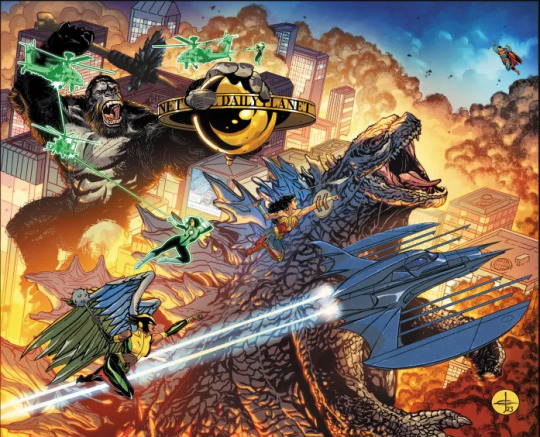
The second has fewer details but features a meeting between three heroes each from Tsuburaya Productions and Marvel Comics:
Ultraman, Ultraseven and Ultraman Taro meeting Spider-Man, Captain Marvel and Iron Man. Not much is known about this one but this promo image features classic Ultra Kaiju Bemular!

#Comics#Crossovers#Justice League#Godzilla#Kong#Ultraman#Ultraseven#Ultraman Taro#Spider-Man#Captain Marvel#Iron Man#Legendary Monsterverse#DC Comics#tsuburaya productions#Marvel Comics
48 notes
·
View notes
Photo
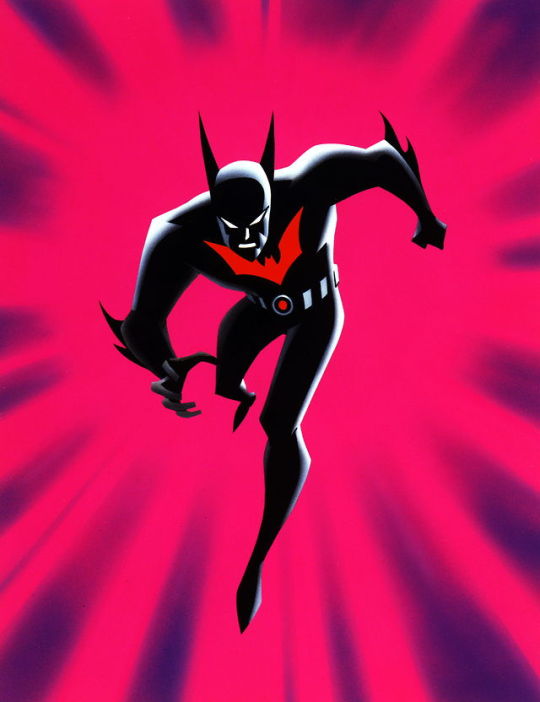
Batman Beyond
Batman: Hush
Teen Titans Go! Vs. Teen Titans
All three at Comic Con International in San Diego over the July 17-21 weekend.
Batman Beyond
Batman Beyond 20th Anniversary Thursday, July 18 – 12:15-1:15pmProduced by Warner Bros. Animation, Batman Beyond won two Emmy Awards and three Annie Awards as it captured the imaginations of a new generation of Batman fans, setting new standards for super hero storytelling with innovative designs, outstanding voice acting and an intriguing approach to DC’s iconic characters and stories. The series also spawned an acclaimed animated film, Batman Beyond: Return of the Joker. Come celebrate the series’ 20th anniversary with many members of the creative team behind the breakthrough production, including producers Bruce Timm (Batman: The Animated Series) and Glen Murakami (Teen Titans), eight-time Emmy Award-winning casting/dialogue director Andrea Romano (Justice League), director James Tucker (Batman: Hush), writers Bob Goodman (Elementary, Warehouse 13), and Stan Berkowitz (Justice League: The New Frontier), and the acting stars of the series—Kevin Conroy (Batman: The Animated Series) and Will Friedle (Boy Meets World, Kim Possible), the voices of Batman and Terry McGinnis, respectively. Stay to the end for some exclusive prizes and cool announcements. Hall H
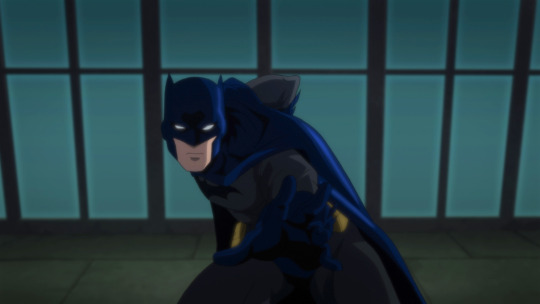
Batman: Hush
World Premiere of Batman: Hush
Friday, July 19 – 7:15-9:15pm
Warner Bros. Home Entertainment, DC, and Warner Bros. Animation returns for their traditional Friday night Comic-Con World Premiere of the latest DC Universe movie, and this time it’s a doozy—the long-awaited Batman: Hush. An adaptation of the seminal DC classic tale, Batman: Hush centers on a shadowy new villain known only as Hush, who uses Gotham’s Rogues Gallery to destroy Batman’s crime-fighting career, as well as Bruce Wayne’s personal life—which has already been complicated by a relationship with Selina Kyle, a.k.a. Catwoman. Meet the filmmakers and voice cast behind this new classic for a post-screening panel that will include Jason O’Mara (The Man in the High Castle) and Jennifer Morrison (Once Upon a Time) as the voices of Batman/Bruce Wayne and Catwoman/Selina Kyle, respectively; Geoffrey Arend (Madam Secretary) as the Riddler, Hynden Walch (Teen Titans Go!) as Harley Quinn, Bruce Thomas (Legally Blonde, Kyle XY) as Jim Gordon, director Justin Copeland (Reign of the Supermen), screenwriter Ernie Altbacker (Teen Titans: The Judas Contract), character designer Phil Bourassa (Young Justice), and executive producer James Tucker (Reign of the Supermen). Batman: Hush arrives on Digital starting July 20, 2019; on 4K Ultra HD Combo Pack, Blu-ray Combo Pack on August 6; and the DC Universe streaming service on August 13. Ballroom 20
Batman: Hush Encore Screening
Friday, July 19 – 9:30-11:00pm
Missed it the first time? Loved it so much, you must see it again. Warner Bros. Home Entertainment is proud to offer a second helping of its all new DC Universe Movie—the much-anticipated Batman: Hush. An adaptation of the seminal DC classic tale, Batman: Hush centers on a shadowy new villain known only as Hush, who uses Gotham’s Rogues Gallery to destroy Batman’s crime-fighting career, as well as Bruce Wayne’s personal life—which has already been complicated by a relationship with Selina Kyle, a.k.a. Catwoman. Batman: Hush arrives on Digital starting July 20, 2019; on 4K Ultra HD Combo Pack, Blu-ray Combo Pack on August 6; and the DC Universe streaming service on August 13. Ballroom 20
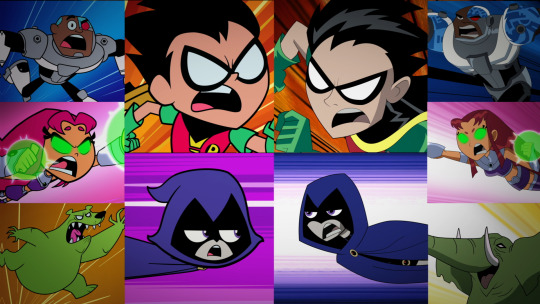
Teen Titans Go! Vs. Teen Titans
World Premiere of Teen Titans Go! Vs. Teen TitansSunday, July 21 – 12:00-2:00pmWhen the forces of evil unite from across time and dimensions, it’ll take the combined efforts of distinctly different, yet similar super hero teams to keep the universe secure in Teen Titans Go! Vs. Teen Titans. Come for the World Premiere of this blockbuster film, then stay for an incredibly entertaining panel discussion featuring the stars of the film—Greg Cipes (The Middle, Teenage Mutant Ninja Turtles) as Beast Boy, Scott Menville (LEGO DC: Batman: Family Matters) as Robin, Khary Payton (The Walking Dead) as Cyborg, Tara Strong (Batman: The Animated Series, My Little Pony, Unikitty!) as Raven, Hynden Walch (Adventure Time, Groundhog Day) as Starfire, Grey Griffin (Scooby-Doo franchise, DC Super Hero Girls, The Fairly OddParents) as Mrs. Claus, and some surprise special guests . . . alongside producer/director Jeff Mednikow (Be Cool, Scooby-Doo!, Teen Titans Go!), screenwriters Marly Halpern-Graser (Batman vs. Teenage Mutant Ninja Turtles) and Jeremy Adams (LEGO DC: Batman: Family Matters). Produced by Warner Bros. Animation and DC, the feature-length animated film arrives from Warner Bros. Home Entertainment this fall on Blu-ray Combo Pack, DVD and Digital. 6BCF
#batman#dc comics#teen titans#teen titans go#batman beyond#sdcc#sdcc2019#comic con#news#notes#comic books
43 notes
·
View notes
Photo
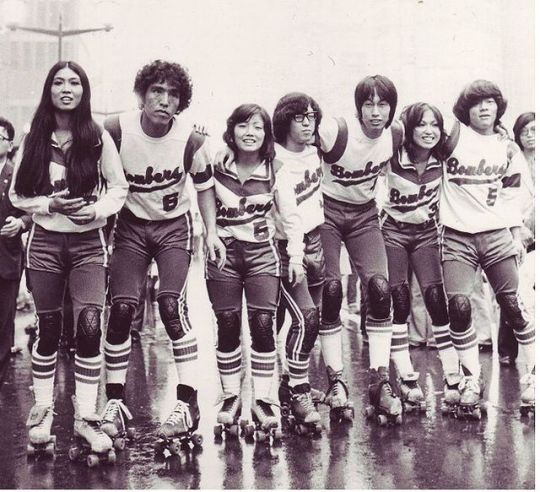
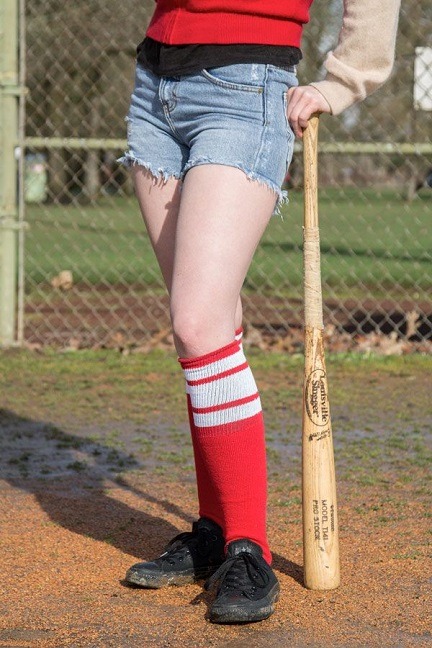
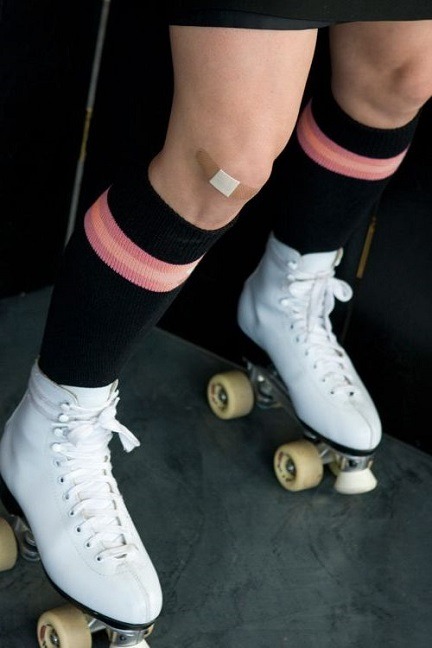
Socks Through Time: History of Top-Stripes
If you've been paying attention to fashion trends for 2018, you may have noticed that top-striped styles are currently a must-have. Being the nerds and amateur historians that we are, we decided to look into the history of this look, and the results were both surprising, and reassuring.
But what is surprising about the history of top-stripes? Well, in this day and age we tend to associate the look with sporty styles, and for most of the 20th century that's really what a top-striped sock was: athletic. However, in our research we were excited to find some super-elegant top striped stockings, such as this beautiful "clocked" style (for more info on clocking, see one of our previous blogs, Historical Costuming Part 2!) from the late 17th century.

Image under public domain, sourced from metmuseum.org, a Gift of Henri-Marcel Cadgene, 1955
Here the top stripes appear to tie the gold clocked design into the overall composition of the stocking, and may also serve to provide a reinforced/more textured area for era-appropriate ribbon garters to grip, since the blue body of the stocking would have been a fine silk. This is really just an assumption on our part, but we think it's safe to say that these were not intended for athletic wear.
The earliest appearance of something like top-striped athletic socks that our internet sleuthing skills could unearth happens in the 1910's, which seems to be about the time that sports teams began adopting them as uniform socks. Interestingly, the two or three stripes on these styles weren't placed at the very tops of the socks, but when you look at the way the members of the 1912 West Point football team (can you spot the former US President in their line-up?) wear pants that come to just below their knees, overlapping with the tops of the socks, it begins to make sense. In this context, the stripes are about as high up as you can see on the sock, creating the illusion of "true" top-stripes. On the other hand, the North Carolina Tarheels Men's Basketball team of 1911 wore shorts, which gives us a better look at their socks!
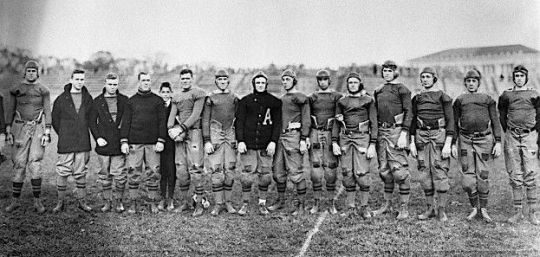
West Point Football Team, 1912. Public Domain via wikimedia commons.
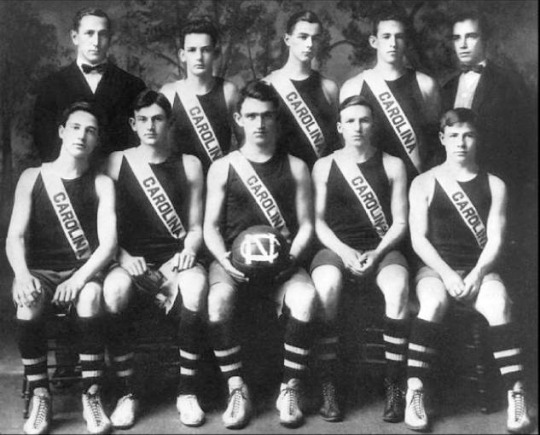
North Carolina Tarheels Men's Basketball Team, 1911. Public domain via wikimedia commons.
But American Football is not the only football at play here, and the top-striped sporty sock style was definitely not confined to the 1910's! Enter Dick, Kerr's Ladies Football Club of Lancashire, England! This team was wildly popular from 1917 until 1965, when women's teams were banned by the Football Association, supposedly because women were too delicate to play sports, but most likely in reality because the women's games regularly outsold the men's games that were held on the same days. While we don't have photographic evidence of every iteration of their uniforms, we have got these lovely photos of their team from the early 1920's sporting thick, ribbed black socks with top stripes, not unlike our Sporty Stripe OTKs!
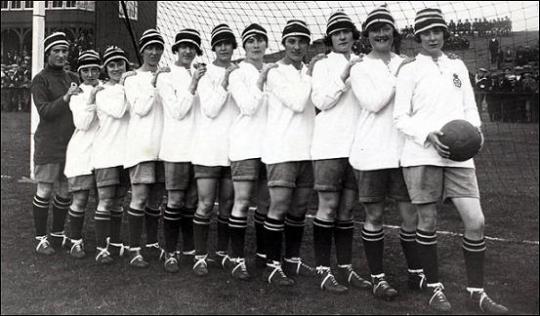
Dick, Kerr's Ladies F. C., 1921. Photo is US public domain, via wikipedia.
For a better look at those nice thick turn-cuff socks, we present you with this (incidentally adorable) photo of the team captains kissing.

The team captains, 1920. Public domain, via wikimedia commons.
Now, some of you sports enthusiasts might be wondering about a certain other ballgame with a long history of sock-related superstition, as well as multiple teams named after socks. If that wasn't enough hints, we're talking about baseball! Though the earliest uniforms used solid colored socks, by the 1930's these sporty little details had worked their way into baseball uniforms too! As you can see from this photo of the American League's 1937 All-Star players, different teams used different numbers of stripes, while the Yankee's stuck with solids (maybe because they're already wearing pinstriped uniforms). Of course the Red Sox are the sock-themed team, so it makes perfect sense that their socks would have the most stripes!

From left to right Lou Gehrig, Joe Cronin, Bill Dickey, Joe DiMaggio, Charlie Gehringer, Jimmie Foxx, and Hank Greenberg. Image sourced via Library of Congress, Harris & Ewing photograph collection.
Taking a closer look at the above image, you might also notice that those socks are lacking certain socky features... things like heels and toes. It appears that these were a sort of stirruped over-sock, which covered the white socks that you can see peeping out of their shoes. While we weren't able to find much information about this particular feature in our researching, our best guess is that this allowed for consecutive wears of the uniform "socks" without washings in-between, as the more generic foot-covering under-socks could be traded out for clean pairs each day -- it's the same reasoning behind this author's love of our Long Cuffable Scrunchable Leg Warmers. It's like my favorite socks, but I can wear them every day for weeks without washing them!
But ball sports weren't the only sports to get in on this trend! What about puck sports? You know, hockey! Introducing the Preston Rivulettes of Canada! We were delighted to discover photos of this women's hockey team in what looks like something akin to our Super Long Ribbed Leg Warmers, only with sporty stripes! Now, like the early rugby socks we looked at, the stripes aren't at the top of the sock (or sock-like garment), but their sparseness is what gives them that distinctly sporty look. Somehow two stripes just looks more aerodynamic than a whole sockful of stripes!
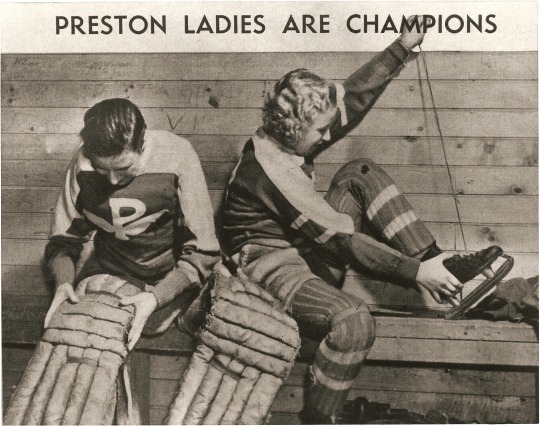
Preston Rivulettes Postcard, 1940. Public domain via Wikimedia Commons.
Now let's get back to football. Or is it soccer? You know -- the one with the spherical ball! Foot(spherical)ball is by far the most popular sport internationally, and like any sport their fans are passionate. We mention this only as framing for the following image, because we want you to really feel the excitement of the moment captured! The year is 1966, and Club Atlético Peñarol of Uruguay has just won the Copa Libertadores de América -- the premier South American football club tournament. Though Peñarol had won the first two editions of the tournament in 1960 and '61, this was their big comeback after other teams took the title in 1962 - '65. You can tell from the spirit of the photo that this was a big moment for the team, as they run across the field celebrating. Possibly even more exciting is the fact that they appear to be wearing almost the exact same socks as the Dick, Kerr's Ladies Football Club circa 1921! To our minds, this firmly places the top striped athletic sock is the Classics category, along with the Doric column.
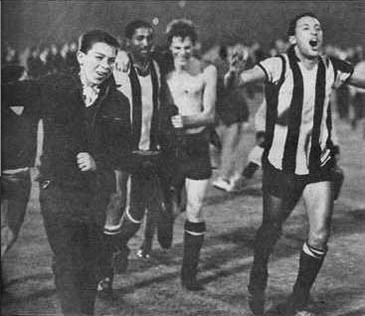
Club Atlético Peñarol's 1966 Copa Libertadores victory. Public domain, via Wikimedia Commons.
And because we just can't get enough of those groovy soccer uniforms, it's time we took a look at what's been lauded as one of the most attractive uniform designs in football history, belonging to the Peru National Football Team. The white jerseys with red horizontal "sashes" are designed to reference games played between schools, in which both teams would wear white shirts with a removable colored sash, to easily distinguish team members. The uniform also features white socks with red top-stripes, to match.
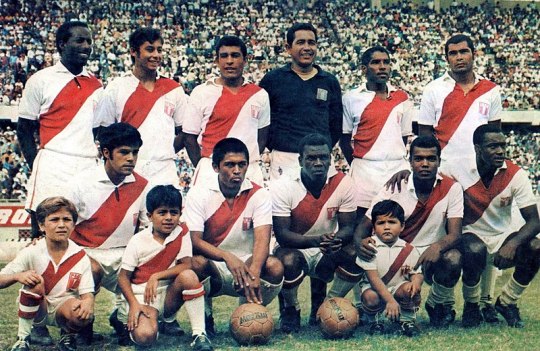
Peru 1970 National Football Team. Public domain, via Wikimedia Commons.
You may have noticed that the era we most associate with top striped socks is the 1960's and especially the 1970's. Another big trend that emerged at around the same time, and which coexisted beautifully with the aforementioned socks, was skating. Roller skating had already been around since 1760, and in a way it was roller skates that gave birth to the first skateboards in the late 1940's, which consisted of wooden planks with added roller skate wheels. The early 70's saw the invention of polyurethane wheels, which made for a smoother ride, better traction, and generally a more enjoyable experience. This precipitated a sudden rise in popularity for skating, and brought us the iconically 1970's skater fashions that we know and love today!

From the first Tokyo Bombers: Yasuko Sasaki, Tiger forest, Yumiko Horii, Rikki Endo, Kazuo Kono, Keiko Ayabe, Mickey Kakuda. Public domain via Wikimedia Commons.
For whatever reason, we found it next to impossible to find public domain photos of 1970's skateboarders, so while we aren't able to post the great photos we looked at here, we're happy to link you to them! We were really into this collection of Los Angeles skateboarders by photographer Hugh Holland. You can also find some interesting background information on how the skateboarding trend was influenced by a severe drought!
House Brand Top-Stripes
At last we have arrived at the point in our Sock Journal where we show you what we've got! Options for recreating this ultra-sporty look are luckily quite plentiful, so let's start out with some of our house brand options! While we only have two top-striped styles in our Dreamer Socks line, they're some heavy hitters! With 12 different colorways and 28 inch top-stretch, our Dreamer Americana Thigh Highs have rocketed into our top sellers! At a more classic length, the Retro Sport Socks come in three sporty colorways -- depending on your favorite team, we might even have your colors!

Dreamer Americana Thigh Highs * Retro Sport Socks
Our DreaM Stockings line includes a pretty great variety of top-striped styles, some of which are particularly good for that thicker, vintage vibe. Some are even authentically tube socks!
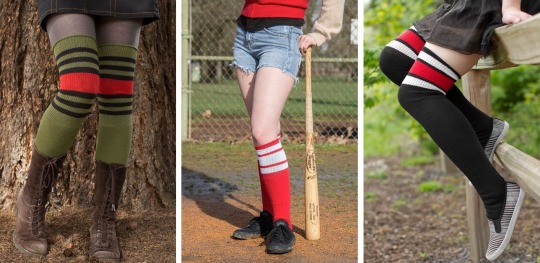
Dreamy Striped Over the Knee Tube Socks * Dreamy Knee High Tube Socks * Top Striped Over the Knee Tube Socks
The Skater Stripes (which are discontinued, so get yours while the getting's good!) and Sorcerer Socks are very similar beasts, only the skater stripes are a cotton blend and come in more stripe variations, while the Sorcerer Socks are nylon and feature colors for the Hogwarts houses.
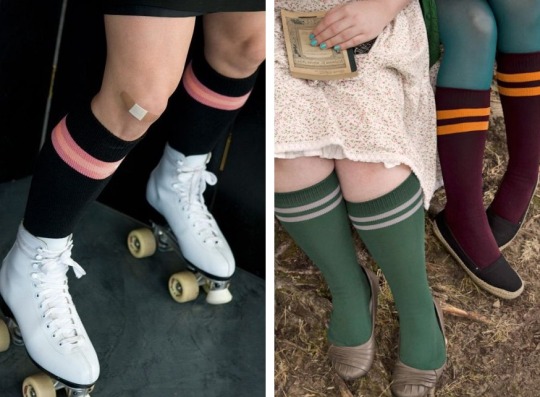
Skater Stripes * Sorcerer Socks
The Skater Stripes are being phased out in favor of some of the newer options we now carry, including the taller, ribbed Sporty Stripe Over the Knee Socks, which I previously mentioned are a pretty good match for those 1920's soccer uniform socks.
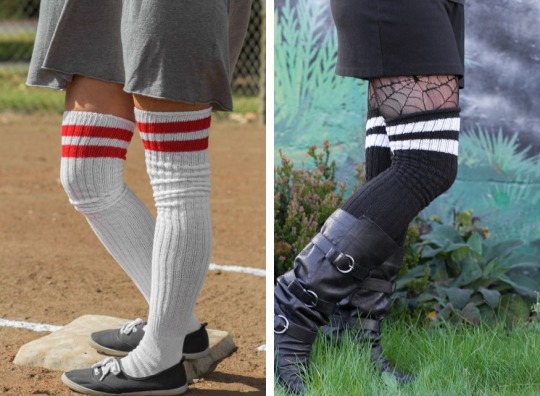
Sporty Stripe Over the Knee Socks
The final styles on our tour of house brand top stripes combine two of our favorite things: marled yarn and top-stripes! If you've been following our company over the years, you may have noticed our obsession with marled socks. There was an era when we couldn't find any marled yarns and had no marled socks (after years of carrying O Marleds - the precursor to our M45s and Confetti M45s, which are made on the same machines the O Marleds used to be knitted on) but we found ways of getting around that issue, which is what happens when you're utterly determined to have your favorite pattern. We think the marriage of these two patterns is a match made in heaven!

Top-Striped Marled Slouch Socks * Top-Striped Marled Scrunchable Socks
Other Suppliers's Top-Stripes
Of course we also carry lots of top striped styles from our other suppliers! For instance, most Gumball Poodle socks, which are made in the classic "cheer sock" style, come with top stripes, but some go above and beyond, incorporating the top stripe into the design, or in the case of their PRINCESS socks, turning it into a crown.
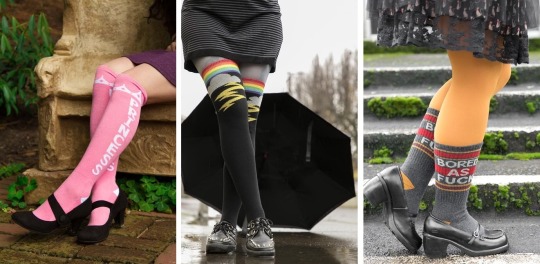
PRINCESS Knee Highs * Stormy Weather Over the Knee Socks * Bored AF Crews
Stance is another supplier that features a lot of top-stripes, and it's not too surprising given that their styles are geared towards skateboarders and surfers! We enjoy the way they mix it up with wild patterns from time to time, too!

Durango Midcalves * Mega Babe Crews * Me Vs. You Kids' Crews
Another supplier that tends to surprise us with their top-stripes is Leg Avenue. Their offerings tend more towards the hosiery and lingerie end of the spectrum, and yet they manage to work some elegant top stripes into that wheelhouse, which is appropriately "full circle" given that we started out with those fancy 17th century stockings!

Sheer Stockings with Striped Tops * Over the Rainbow Thigh High * Lurex Anklets
Of course we have plenty of other top-striped options, but to feature all of them would make for a very long blog indeed. Instead, we encourage you to check out the entire top-striped collection, because there's a reason this look never seems to go out of fashion. As a style that has been around for centuries, top-stripes are truly timeless.
♥~Rosalind
Socks by Sock Dreams • Free Shipping in the US • $5 International Shipping
Find us on facebook | twitter | pinterest | instagram | sock journal | g+
#fashion#history#socks#sports#stripes#sport socks#top-stripes#hockey#football#soccer#american football#roller skating#skate boarding#sfw
53 notes
·
View notes
Text
Datamining Update: New Little Jungle Cup, and more on Powered Up Pokéstops & <b>Gyms</b>
4x Stardust! Ultra League Classic; Master League Premier Classic. Power up POI's. Tutorial; Power Up Pokéstops; Power up Gyms; Location Points!
from Google Alert - gym https://ift.tt/37s2ikG
0 notes
Text
Should I keep my fingers crossed for Premier Ultra League Classic to ever exist or should I just stop doing anything other than Great League
If you use XL Great League mons in Premier Ultra League you are a bad person and you owe me money
0 notes
Text
Pokémon Go Ultra League Premier Classic- Best Pokémon to use
Pokémon Go Ultra League Premier Classic- Best Pokémon to use
THE Pokémon Go rounds in the Battle League change over soon, and people are already planning their teams for the new meta.Starting December 15 at 8pm UK time, the Ultra League Premier Classic will return, bringing a new ruleset to the game.
Read Full Text

View On WordPress
0 notes
Photo

Batman Christmas Gift Guide
We’ve made a listed of some great gift ideas for that Bat-fan in your life and the best way you snag them up for yourself!
Batman The Animated Series: Harley Quinn
Deluxe 25th Anniversary PVC Figure by Diamond Select Toys

Diamond Select Toys has had a ton of incredible collectibles come out this past year, and this one may be the best! A definite 10 out of 10! It’s a fantastic way to celebrate the 25th Anniversary of Harley Quinn. Check out our full review here and purchase yours at the link below.
==> ORDER INFO
Batman: The Complete Animated Series
Deluxe Limited Edition

After years of waiting, Batman: The Animated Series has finally been released in HD. This limited edition release in a Bat-fan’s dream come true! It includes all 109 thrilling episodes, plus two bonus disks containing the recently-remastered, fan favorite animated films Batman: Mask of the Phantasm and Batman & Mr. Freeze: SubZero, The box set’s premiere bonus feature is, The Heart of Batman, an impressive 90-minute documentary on the making of Batman: The Animated Series that includes interviews with nearly three dozen members of the cast and crew, detailing the intricacies of production behind the landmark animated show.

The package features approximately 2,700 minutes of entertainment spread over 10 Blu-ray™ discs, plus the two bonus discs – not counting 11 specially-selected episodes with audio commentaries by cast and crew. In addition, Batman: The Complete Animated Series Deluxe Limited Edition includes an exclusive ensemble of collectibles highlighted by three Funko mini-figurines (Batman, Joker, Harley Quinn) and seven beautifully-designed lenticular art cards. The entire box set is housed in a stunning layflat-book with a dazzling slipcase.
==> ORDER INFO
Batman: The Animated Series
The Joker Artfx+ Statue by Kotobukiya
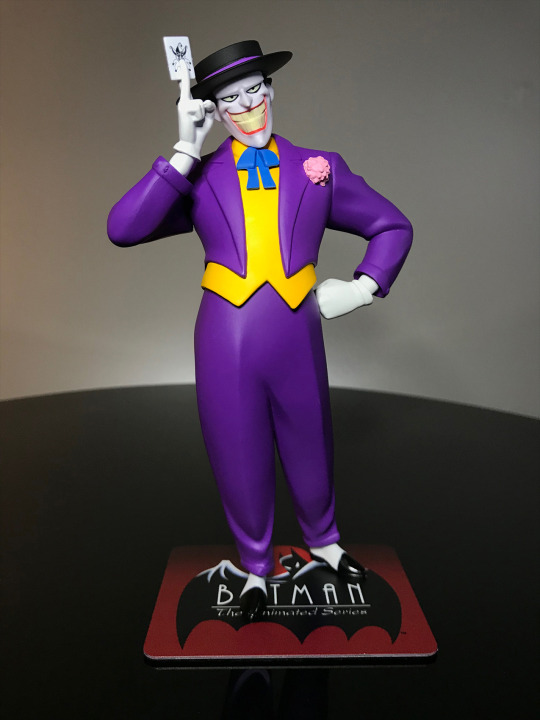
Kotobukiya has released three Batman: The Animated Series statues with interchangeable faces. This one’s our favorite! It not only look amazing, but it’s fun to replace the changeable parts. Check out our full review here and purchase yours at the link below.
==> ORDER INFO
Batman - Original Motion Picture Score LP
by Mondo
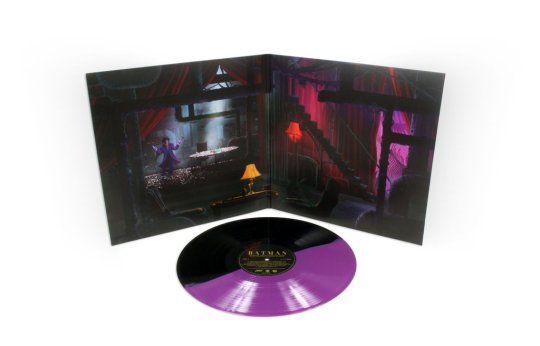
Mondo celebrates the 30th anniversary of Tim Burton’s BATMAN with a reissue of Danny Elfman's original score to the film.Danny Elfman’s score to BATMAN is a career defining, monumental achievement in film music - in 1989 Elfman became a household name, when he created this iconic score - and in doing so permanently set the high-water mark for not only the music of Batman, but of superhero films as a whole. Remastered and Pressed on 180 Gram Black and Purple Split colored vinyl (also available on 180 Gram Black Vinyl) This re-issue is the first time the album has been available on Vinyl in 30 years.
ARTWORK BY: Kilian Eng
==> ORDER INFO
Batman: Prelude to Knightfall
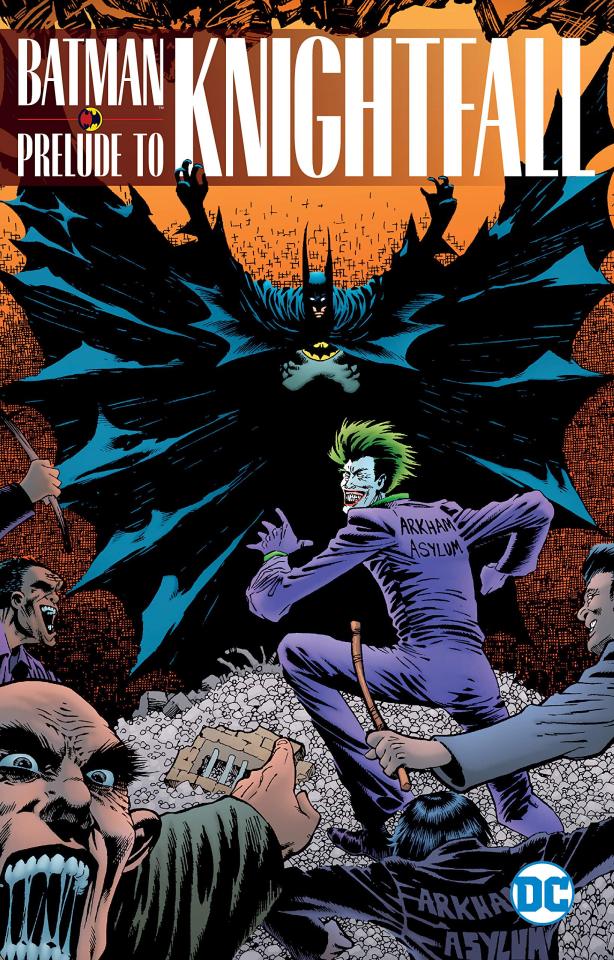
The epic story of Batman and Bane by legendary author Chuck Dixon starts here. Gotham City is home to a riot of deadly criminals. The Joker, Poison Ivy, the Mad Hatter and Killer Croc have all done their best to bring anarchy to the city's streets, back alleys and sewers. Thankfully, Gotham is also home to the Batman. Throughout the years, he's been able to keep his infamous rogues gallery in check. But now, lurking at the end of this seemingly endless gauntlet of foes, emerges the deadliest menace of all--a wild berserker known as Bane. It is his destiny to destroy Batman and take control of Gotham City.
Batman: Prelude to Knightfall kicks off an ambitious nine-volume saga that revisits Batman's memorable and life-changing battle with Bane. Collects Batman: Vengeance of Bane #1, Batman #484-491 and Detective Comics#654-658.
==> ORDER INFO
Dark Knight Trilogy in Ultra HD

Arguable the greatest movie franchise of our time, Christopher Nolan’s Batman films get 4K treatment here, with the absolute best picture and sound currently available!

==> ORDER INFO
QMx Batman Batarang
1:1 Scale Prop Replica

Batman Batarang is a 1:1 Scale Prop Replica with the quality of QMx Caliber Metalworks
Developed from the screen used prop and created using laser-cut molds
Batarang is 8.5" x 3.25" and base is 10.5" x 6.25"
Batman Batarang is made of steel, polished chrome, polyurethane leather.
Quantum Mechanix Batarang 1:1 Scale Replica as seen in the movies Batman v Superman: Dawn of Justice, Suicide Squad and Justice League (2017).
==> ORDER INFO
LEGO Batman Movie The Scuttler 70908

Build Batman’s awesome robotic bat vehicle with extending arms, secret jetpack and a launching net shooter!
Featured in THE LEGO BATMAN MOVIE
Includes Batman, The Joker, Commissioner Gordon, Barbara Gordon, Dick Grayson and Poison Ivy with buildable vine monster
THE LEGO BATMAN MOVIE building toys are compatible with all LEGO construction sets for creative building
The Scuttler is over 8” high, 9” wide and 10” long with arms retracted, and over 14” long with arms extended. Vine monster is over 1” high, 4” wide and 4” deep
775 pieces – For boys and girls between the ages of 9 and 14 years old
==> ORDER INFO
Hot Wheels Collector Batman Returns
Batmobile Die-cast Vehicle (1:18 Scale)

Tim Burton’s Batmobile done by the classic Hot Wheels Collectibles Company. (1:18 scale)
==> ORDER INFO
#batman#dccomics#dc comics#comic books#dark knight#batmobile#toy#toys#Christmas#list#joker#lego#harley quinn#diamond select toys#kotobukiya#mondo#collectibles#12032018#p112052018#12072018
20 notes
·
View notes
Text
Liverpool can’t possibly blow a Premier League title, right?

This past weekend: 1) Liverpool lost 2) German fans said mean things about a billionaire 3) the goal of the year was scored 4) you forgot there was a clásico.
Hello, and welcome back to Tactically Naive, SB Nation’s weekly soccer column. We’ve spent the morning listening to Ennio Morricone soundtracks and now we are invincible.
The greatest moment of Arsenal’s season
It is a time of portents. Floods rack the land. Birds fly backwards. Oleg Luzhny is looking at his own arm and thinking “Hmm. Tasty.” And then, this weekend, it happened. The ur-sign; the flaming comet to end all flaming comets. Some of us couldn’t remember the last time it had happened. Some thought it never would again.
Liverpool. Lost. A. Game. In. The. Premier. League.
Well, to be precise, they didn’t lose. They got tonked. By a team that began the day in the relegation zone. Liverpool looked slow, uninspired, and unimaginative going forward, and excitingly vulnerable at the back. If you’d asked a newly-reawakened Rip Van Winkle which team was a million points clear at the top of the Premier League, he’d have said:
”What, 2020? Oh man, how long was I out? How many King Georges are we up to now? Must be, like, XII. Do people still play nine-pins?”
Well, that didn’t work. But if you’d asked somebody who was broadly familiar with the time period but had mysteriously been asleep for long enough to know the specifics, they’d have said:
”Probably still Liverpool, right? Sure, they’re having a bad day, but when was the last time Watford were miles clear at the top of anything? Ohh, this Ismaïla Sarr’s pretty decent, hey? I’m hungry.”
We just cannot get the imaginary staff.
Anyway. Rather unexpectedly, this is turning into a sticky couple of weeks for the champions-elect, greatest team in history, unstoppable red machine. They’re 1-0 down halfway through their Champions League tie against Atlético Madrid, they’ve lost to Watford, they conceded twice to West Ham — West Ham! — and coming up, on Tuesday evening, they’ve got a tricky FA Cup tie against Chelsea.
Given the way they’re playing, it’s not beyond the bounds of possibility that they end up out of both remaining cup competitions before March is halfway done marching. Liverpool fans won’t care, of course — the league! the league! — and you’d be a fool to bet against another one of Those Famous European Nights At Anfield.
But generally speaking, the teams that find their seasons over in March are those at the other end of the table, the helplessly and hopelessly relegated. The last act of this remarkable season could yet be rendered a little strange: an edgeless procession to an already-won title, and a surprising number of days off. Unless …
… no. No. Losing the league title from here would be apocalyptically unthinkable …
… apocalyptically …
… unthinkable …
… so, stop thinking about it? No. Shan’t. You first.
Sometimes people tell you who they are
Elsewhere in Europe, it finally happened. Referees, club officials, and players took note of unacceptable abuse from the stands and brought a game to a halt. Finally, action is being taken against the discrimination that blights our game: fans being rude to billionaires.
The billionaire in question is Dietmar Hopp, who owns and funds Hoffenheim out of his vast pockets. This vexes ultras groups around Germany, not least because it represents a violation of Germany’s famous 50+1 rule, which is supposed to ensure that clubs remain majority-owned by the fans.
There’s much winding backstory to the protests which erupted this weekend, but in extremely brief, what happened was this. First, Bayern’s ultras unfurled a series of banners, all variations of “Dietmar Hopp — son of a whore!” Then, in response, Bayern’s and Hoffenheim’s players, the referee, and Bayern’s club officials all flipped their collective wig.
The players were taken off the field, then reemerged to see out the last 20 minutes by just passing the ball to one another. There was talk of abandonment, then later of a dark day for football. Karl-Heinz Rummenigge even accused the ultras of ruining the club’s birthday. The big meanies.
You may be thinking: seems a bit much. You may also be thinking: where is all this energy, this fury, this doomsaying, when players are racially abused from the stands? Well, Tactically Naive is right there with you. Indeed, it’s hard not to read this as a pointed expression of class solidarity: they stand with Dietmar Hopp; they stand only with Dietmar Hopp.
This parallel has not passed unremarked by the ultras. A statement from Red Fanatic Munich (translation here) makes the point, and notes that Hopp himself has equated criticism of his stewardship of Hoffenheim with racial discrimination. It then castigates the DFP for appearing to agree with him, and the media and Bayern’s players and hierarchy for the “lack of substance” in their responses so far.
While we wait for the fallout, we can chalk this up as yet further evidence that reality’s boss is barely even checking emails at the moment. Football won’t stop play for racism but will for incredibly rich people? There’s no way any self-respecting satirist would have been allowed to get away with that. Our world isn’t just stupid. It’s badly edited.
PING
Bloody hell.
A potential candidate for the #Puskas Award?
Take a bow, Jordan Flores
Will we see this stunner nominated at #TheBest?pic.twitter.com/TZgF8asFzX
— FIFA.com (@FIFAcom) February 28, 2020
We’ve watched this goal a lot, and we still don’t quite understand the mechanics of it. It looks like it’s going to be merely spectacular, in a Zlatan sort of a way, and then just as the ball arrives there’s a weird glitch. It’s as if his entire body sneezes itself into a different shape. A bazooka, perhaps. Or a large animated six-shooter. And then he loads the ball, spins the chamber, and Roger Rabbits the ball into the goal.
Keeper gets a little touch, mind. Imagine if he’d saved it. Imagine the giddy Dadaist rush of ruining something that beautiful. Ah well. At least goal of the season’s sorted nice and early.
Oh, there was a clásico as well
Well, sort of.
Watching the clásico shuffle apologetically past, TN couldn’t help but wonder if this game will ever be That Game again. That glorious run of unimpeachable classic nonsense that stretched, roughly, from Ronaldinho’s ovation through to Mourinho’s desecration: did we take that for granted? Did we play ourselves, raise our expectations so high that nothing could match them?
Or are we perhaps now truly living after the golden age, the towers fallen, watching faded parodies pass through the motions. The pulse of the thing long ebbed away. Barcelona were meek. Madrid were better, in a highly localised sense. And the title race is still twitching away. That’s something, right? That’s something.
0 notes
Text
Real Cricket 17 Mod 2.8.0 Apk [Unlimited Coins]
New Post has been published on https://www.allmoddedapk.com/real-cricket-17-mod-apk/
Real Cricket 17 Mod 2.8.0 Apk [Unlimited Coins]

Real Cricket 17 Mod 2.8.0 Real Cricket™ is here and here to stay! We have migrated to a brand new experience with Real Cricket™ 17! The most complete cricket Sports game in the world!
For all you cricket fans out there, Intensity of a Real Cricket™ game, now on your mobile!!!
Welcome to the most authentic, complete and surreal Cricket experience on Android – Real Cricket™ 17
ALL NEW MULTIPLAYER
Battle it out against your friends or other Real Cricket players in a Batting Showdown. Outscore your peers and top the leaderboards!
PREMIER LEAGUE AUCTIONS
Just like next year – take charge of your favourite franchise and build a team from scratch!
INCLUDES TEST MATCH
Brand new Test Series mode complete with updated rosters, the classic whites and lunch-tea breaks.
CHAMPIONS CUP
Be part of the Mini World Cup gala and bring the trophy home for your country!
UNIQUE AND NOVEL REAL CRICKET CHALLENGE MODE & DAILY CHALLENGES
For the First Time Players can play out Historical Scenarios with a unique level based saga experience. Also get daily challenges based on recent and past events!
ALL MAJOR T20 DOMESTIC TOURNAMENTS
More content than you can imagine. From South Africa, the Caribbean, Down Under, England, Pakistan, Bangladesh. Play them All
ALL NEW PLAYER PROFILE
Track all yours Stats and Increase you’re Rank. Be the Best
FRESH LOOK AND FEEL
The game is now smoother than ever and with the most stunning presentation.
ULTRA FLUID SIGNATURE REAL CRICKET™ ANIMATIONS
Scintillating 2D Motion Captured animations
BE STRIKING WITH AUTHENTIC CRICKET EQUIPMENT
Authentic Cricket equipment provided by legendary manufacturers – Gray-Nicolls and SS Cricket.
CRICKET QUIZ
New for Trivia maniacs. Think you know it All? Test your skills with the Cricket Quiz
ALL NEW DETAILED LEADERBOARDS
Now Compete with Friends & Players from around the World
ALL NEW HARDCORE DIFFICULTY
Want the Game to Be Harder. Well we tried! It’s your turn now…
This app offers in-app purchases.
*Permissions:
To deliver the best experience we would need some permissions from our users:
GET_ACCOUNTS: This permission is required to access Google Game Play Services including Login, Achievements and Leaderboard.
WRITE_EXTERNAL_STORAGE and READ_EXTERNAL_STORAGE: We need these permissions to cache and read game content during the gameplay.
READ_PHONE_STATE: We need this permission to serve you relevant notifications on various updates and offers.
ACCESS_FINE_LOCATION: We need this permission to detect your location so as to provide region specific content as well as analyze your regions needs and feedback better.
RECORD_AUDIO: This is required for Zapr SDK which is integrated within this app to analyze offline TV viewing data and serve media-targeted ads. If you’d like to opt-out of this targeting, please visit the following link: http://www.zapr.in/privacy/
0 notes
Text
5 for June
It’s July! I can’t believe how 2017 is flying by. June marked our ‘half year’ in Nashville, which is scary!
June was a very busy month for the city of Nashville – it hosted the annual CMA Fest (country music festival) and saw our Predators make it to the Stanley Cup Final (a huge achievement for this little ice hockey town!). Of course, some of these things featured in our ‘5 for June’ list – so here you have it, this is what we got up to last month…
Check out CMA Music Fest
The CMA Music Fest is somewhat of a pilgrimage for country music fans. Hundreds of thousands cowboy boot-wearing people turn up for the long weekend, when Broadway is taken over with pop-up stages, the Nissan Stadium hosts sell-out gigs every night and you never know which country star you’re going to bump into downtown. We didn’t buy tickets to the main event, but there were plenty of free gigs to take advantage of. We headed down on a sunny Saturday evening to the Ascend Amphitheatre (a very cool outdoor theatre with a stunning backdrop of the city skyline) to catch several up-and-coming country acts. We even discovered a few new favorites to download when we got home!
And, no, before you ask... still no cowboy boots!
Sip on Tennessee wine at Arrington Vineyard
Just 30 minutes south of the city is a sweet little vineyard which makes some lovely Tennessee wine. Wine isn’t really much of a big deal around here so we don��t have it much – it was nice to head down there and try some out. The great thing about this place is that you can turn up with your own picnic, listen to some live bluegrass... all whilst sipping on a flight of some of their many wines. I particularly enjoyed the blackberry wine. A great Sunday afternoon activity and one we’ll be sure to repeat with visitors.
Cheer on the Preds!
I mentioned that it was a busy month for Nashville. Not only did it host thousands of country music fans, but also a whole load of hockey fans, as our team – the Nashville Predators – made it all the way to the Stanley Cup finals. This was HUGE – think of Leicester City winning the Premier League and you can appreciate the excitement and magnitude of the event. The city (Smashville as the Preds like to dub it!) went INSANE. As the final series (7 games, or first to win 4) kicked off every other night was a party downtown with the games on big screens, yellow t-shirts everywhere, and lots of throwing of catfish (Google that story). The Major of Nashville even declared one Monday as ‘Preds Pride Day’ (complete with an official ‘late to work’ note for those who had a late one watching the game ;-)). Unfortunately we didn’t make it all the way to the win, but we sure had a lot of fun along the way. We played our role cheering on the Preds in the fan park, along with 5,000 of our fellow Nashvillians.
Visit Hog Heaven
There is no better way to distract Pete than with BBQ food, his ultimate fave. During the painful wait to hear back on his job interview we went one evening to try this place out and take our minds off the waiting! Although it’s not much to look at (a tiny shack on the side of Centennial Park), Hog Heaven has been serving up tasty BBQ grub since 1989 and has featured on many TV shows. Given all the BBQ we get to sample down here, we are starting a bit of a rating system. This place definitely tops it for smoked baked beans!
Explore SoBro:
SoBro is, unsurprisingly, the part of town south of Broadway. It also happens to be where Pete’s new job is – so very convenient for the purpose of this item on our list! :-) I met Pete there after work on Friday to celebrate his first full week back as a working man. We tried out a very cool ‘hidden bar’ across the street from his office. We loved the secret bars we found in our European city breaks, but haven’t found many here. This one definitely meets the mark. Won't name it - it's hidden after all! From there we headed towards another famous BBQ spot, Martin’s BBQ, for some delicious brisket and smoked turkey. We ended the night with a very cool event at the Schemerhorn – home of Nashville’s Symphony Orchestra. They were showing E.T., accompanied by the orchestra who played all the music live. A magical experience. Cocktails, BBQ, 1980s movies and classical music – a very eclectic night I think you’ll agree! How millennial of us.
And so I couldn’t finish without a note on the hidden ‘to do’ item that’s featured on our list for a while now – finding a job for Pete. I am very pleased to report that he is no longer a man of leisure, stay-at-home dog-dad, but a working man! Thanks to everyone for asking – his first couple of weeks have gone very well and he’s very enthusiastic about the job – it’s basically his dream role! He is officially ‘Head of Design & Creativity’ (swanky I know!) at a development company that are building ultra-cool residential properties in the city (oh, and on a small private island in the Caribbean…! The perks.). He’s very pleased to be back at work and doing something he loves.
So what about little Buddy now? Well, he has become my official office companion. I don’t think he’s doing his fair share of the work though… he does a lot of sleeping on the job! J
I hope everyone had a great June and is enjoying the British summer (I hear it’s actually been summerlike!).
We’ve just returned from a fantastic 4th July weekend in Chicago with my parents, so I’ll report on that shortly.
Enjoy July!
0 notes
Text
James Corden at National Live at Home
Oscar winner Parasite debuts on Hulu
She Loves Me on PBS
Jodie Foster and Robert De Niro in Taxi Driver, on Netflix
Anne Hathaway and Hugh Jackman in Les Miserables, on Amazon Prime
There are no “openings” on stage likely this month, but there is much to see online for theater lovers and screen enthusiasts alike. Below is more than just the usual streaming services Amazon Prime, HBO, Hulu, and Netflix, though they’re all there. There’s also the newly created National Theatre at Home, which is streaming recordings of stage shows FOR FREE this month, from “One Man, Two Guv’nors to “Twelfth Night.”
Lovers of live theater should also check out Where To Get Your Theater Fix Online: Old Favorites and New Experiments — everything from BroadwayHD to the new downtown platform TrickleUp to 24 Hour Plays’ Viral Monologues. (Many of the exciting new theater-livestreaming sites haven’t yet planned a month ahead)
\
NBC has announced a rebroadcast of its Emmy-winning Jesus Christ Superstar Live in Concert for Easter Sunday, April 12.
National Theatre at Home
Each filmed production will be streamed for free on National Theatre’s YouTube channel for a week, starting on the date listed
April 2: One Man, Two Guv’nors
The slapstick comedy starring James Corden
April 9: Jane Eyre
Sally Cookson’s adaptation of the Charlotte Brontë classic
April 16: Treasure Island
Bryony Lavery’s adaptation of the Robert Louis Stevenson novel, which premiered at the National in 2014
April 23: Twelfth Night
The 2017 production of Shakespeare’s comedy, directed by Simon Godwin
PBS
Great Performances on All Arts
April 11 10 a.m..: She Loves Me
April 11 1 p.m. : An American in Paris The Musical
April 11 4 p.m.: Noel Coward’s Present Laughter
April 11 7 p.m.: Irving Berlin’s Holiday Inn The Broadway Musical
April 11 10 pm.: Kinky Boots
April 19 5 p.m.: Rodgers and Hammerstein’s The King and I
Playing on Air
The new season of this podcast’s short original radio plays
April 5: The Clam, by Amanda Quaid
After a lifetime of playing it safe , a wistful clam (Tony Shalhoub) decides to come out of his shell, with the help of a therapist (Kristine Nielsen)
April 12: Night Vision by Dominique Morisseau
One night in Brooklyn, pregnant Ayanna (April Mathis) and her husband Ezra (Eden Marryshow) witness a sudden, violent attack.
April 19: Wild and Precious Life by Patricia Cotter
Friends and flames gather to celebrate and remember the life of charismatic, outrageous Sheila (Debra Monk) — but the dearly departed still has one more trick up her sleeve.
April 26: Fake News by Doug Wright
Anchors Bob Tunley and Fran Mercer are the iconic voices behind KLWP News Hour — but today, they’ve become the story. As bizarre and menacing soundbites interrupt their live radio broadcast, the studio crew begins to fear that they’re under attack. Starring Eisa Davis, Jeremy Shamos, Steven Boyer and Kate Finneran.
youtube
Hulu
Hulu highlights: 2020 Best Picture Oscar winner Parasite comes exclusively to Hulu on April 8. The Hulu/FX collaboration Mrs. America, which stars Cate Blanchett as Phyllis Schlafly, premieres April 15. A screen adaptation of Sally Rooney’s popular book, Normal People, will be available to stream on April 29.
April 1
60 Days In: Narcoland, Season 1
90 Day Fiance: Happily Ever After?, Season 4
Alone, Season 6
The Ant Bully
Bangkok Dangerous
Breaking Amish, Seasons 2 and 3
Bend It Like Beckham
Blazing Saddles
The Book Of Eli
The Boost
Bring It!, Season 5
Chopped, Season 36
The Chumscrubber
Cutthroat Kitchen, Season 12
Dance Moms, Seasons 2 and 6
Diary of a Hitman
Diners, Drive-Ins, and Dives, Seasons 27 through 29
Dr. Pimple Popper, Season 3
Dr. Seuss’ Horton Hears a Who
Dr. T. and the Women
The Eternal
The Family Chantel, Season 1
Free Birds
The Food That Built America, Season 1
The Full Monty
Fast N’ Loud, Season 13
Fixer Upper (How We Got to Here: Looking Back on Fixer Upper), Special on HGTV
Forged in Fire, Season 6
Fun in Acapulco
Gator
Get Smart
Gods and Monsters
Gold Medal Families, Season 1
Gorky Park
Hidden Potential, Season 1
House Hunters, Season 120
Hud
The Jewel of the Nile
Kabukicho Sherlock, Season 1
Kids Behind Bars: Life or Parole, Season 1
The Kitchen, Seasons 16 through 18
Kill Bill: Volume 1
Kill Bill: Volume 2
The League of Extraordinary Gentlemen
Let Me In
Little Women: Atlanta, Season 5
Little Women: LA, Seasons 7 and 8
Love It or List It, Season 14
Madagascar: Escape 2 Africa
Married at First Sight, Season 9
Marrying Millions, Season 1
The Mexican
Misery
Moll Flanders
Phone Booth
Property Brothers, Seasons 10 and 11
Repentance
Risky Business
Romancing the Stone
The Sender
Shirley Valentine
Spider-Man
Taken at Birth, Season 1
Til Death Do Us Part, Season 1
TRANsitioning, Season 1
Trapped: The Alex Cooper Story
Victoria Gotti: My Father’s Daughter
Who Let The Dogs Out
The X-Files: I Want to Believe
Zombieland
April 3
Future Man, Season 3
Into the Dark: Pooka Lives
Your Pretty Face is Going to Hell, Season 4
Siren, Season 3 premiere on Freeform
April 6
Too Cautious Hero, Season 1
April 7
No Guns Life
April 8
Parasite
April 9
Who Wants to be a Millionaire?, Series premiere on ABC
Kono Oto Tomare!: Sounds of Life, Season 2A
Little Joe
April 10
Real Housewives of Potomac, Season 4
April 12
My Little Pony: Friendship is Magic, Season 9B
My Little Pony: Friendship is Magic en Español, Season 9B
April 14
The Bachelor: Listen to Your Heart, Series premiere on ABC
The Baker and the Beauty, Series premiere on ABC
Songland, Season 2 premiere on NBC
Vault
Unlocked
April 15
Mrs. America
The Masked Singer: Sing-Along Spectacular, Special on Fox
A Teacher
The Messenger
April 16
What We Do In The Shadows, Season 2 premiere on FX
Harry Benson: Shoot First
April 20
Paranormal Activity 3
A Kind Of Murder
April 22
Special-7, Season 1
April 23
Cunningham
April 24
Abominable
April 29
Footloose
April 30
2020 Billboard Music Awards, Special on NBC
youtube
Netflix
Netflix highlights: All six seasons of the TV series Community, the films The Social Season and Martin Scorcese’s Taxi Driver on April 1. The Good, The Bad and the Ugly on April 2. Despicable Me on April 16.
Also check out the ongoing video-captured Broadway shows, such as John Leguizamo’s Latin History for Morons
April 1
40 Days and 40 Nights
Bloodsport
Cadillac Records
Can’t Hardly Wait
Cheech & Chong’s Up in Smoke
Community: Season 1-6
David Batra: Elefanten I Rummet
The Death of Stalin
Deep Impact
The Girl With All the Gifts
God’s Not Dead
The Hangover
How to Fix a Drug Scandal
The Iliza Shlesinger Sketch Show
Just Friends
Killer Klowns From Outer Space
Kim’s Convenience: Season 4
Lethal Weapon
Lethal Weapon 2
Lethal Weapon 3
Lethal Weapon 4
The Matrix
The Matrix Reloaded
The Matrix Revolutions
Minority Report
Molly’s Game
Mortal Kombat
Mud
Nailed It!: Season 4
The Perks of Being a Wallflower
Pokémon the Series: Sun & Moon: S3: Sun & Moon – Ultra Legends
Promised Land
Road to Perdition
The Roommate
The Runaways
Salt
School Daze
Sherlock Holmes
The Social Network
Soul Plane
Sunderland ‘Til I Die: Season 2
Sunrise in Heaven
Taxi Driver
Wildling
April 2
The Good, the Bad, and the Ugly
Violet Evergarden: Eternity and the Auto Memory Doll
April 3
Coffee & Kareem
La casa de papel: Part 4
Money Heist: The Phenomenon
Spirit Riding Free: Riding Academy
StarBeam
April 4
Angel Has Fallen
April 5
The Killing of a Sacred Deer
April 6
The Big Show Show
April 7
Terrace House: Tokyo 2019-2020: Part 3
April 9
Hi Score Girl: Season 2
April 10
Brews Brothers
LA Originals
La vie scolaire
Love Wedding Repeat
The Main Event
Tigertail
April 11
Code 8
April 14
Chris D’Elia: No Pain
April 15
The Innocence Files
Outer Banks
April 16
Despicable Me
Fary: Hexagone: Season 2
Fauda: Season 3
Hail, Caesar!
Mauricio Meirelles: Levando o Caos
Jem and the Holograms
April 17
Betonrausch
#blackAF
Earth and Blood (La terre et le sang)
The Last Kids on Earth: Book 2
Legado en los huesos
Sergio
Too Hot to Handle
April 18
The Green Hornet
April 20
Cooked With Cannabis
The Midnight Gospel
The Vatican Tapes
April 21
Bleach: The Assault
Bleach: The Bount
Middleditch & Schwartz
April 22
Absurd Planet
Circus of Books
El silencio del pantano
The Plagues of Breslau
The Willoughbys
Win the Wilderness
April 23
The House of Flowers: Season 3
April 24
After Life: Season 2
Extraction
Hello Ninja: Season 2
Yours Sincerely, Kanan Gill
April 25
The Artist
Django Unchained
April 26
The Last Kingdom: Season 4
April 27
Battle: Los Angeles
Never Have I Ever
April 29
A Secret Love
Extracurricular
Murder to Mercy: The Cyntoia Brown Story
Nadiya’s Time to Eat
Summertime
April 30
Dangerous Lies
Drifting Dragons
The Forest of Love: Deep Cut
Rich in Love (Rico de Amor)
The Victims’ Game
youtube
Amazon Prime
Amazon Prime highlights: Most James Bond movies are on offer starting April 1. The Bodyguard with Whitney Houston on April 1. The movie of the musical Les Miserables on April 10. The Joker, with Oscar winning actor Joaquin Phoenix, April 16. The musical drama film Footloose, April 29.
Check out also the musicals and other Broadway shows, some of them taped directly from the stage, that you can rent from Amazon Prime.
April 1
Bangkok Dangerous
Bird of Paradise
Blind Husbands
Broken Blossoms
The Bodyguard
The Boost
The Brothers Grimm
The Chumscrubber
Daniel Boone
Diamonds Are Forever
Diary of a Hitman
Die Another Day
Dishonored Lady
Dollface
Dr. No
Dr. T & the Women
Drums in the Deep South
For Your Eyes Only
From Russia With Love
Gator
Gods and Monsters
Goldeneye
Goldfinger
Gorky Park
The Hoodlum
Hotel Artemis
I Am Legend
Licence to Kill (4K UHD)
Live and Let Die (4K UHD)
The Living Daylights
The Lost World
The Man With the Golden Gun
Mark of Zorro
Moonraker (4K UHD)
Mutiny
Never Say Never Again
The New Adventures of Tarzan
Octopussy
On Her Majesty’s Secret Service
Repentance
The Sender
Shirley Valentine
Son of Monte Cristo
The Spy Who Loved Me
Tarzan the Fearless
Thunderball
Tomorrow Never Dies
A View to a Kill
The World Is Not Enough
You Only Live Twice
The Bureau: Season 1
America in Color: Season 1
Bronx SIU: Season 1
Dirt Every Day: Season 1
El Rey del Valle: Season 1
Foyle’s War: Season 1
The Mind of a Chef: Season 1
Molly of Denali: Season 1
Mr. Selfridge: Season 1
Our Wedding Story: Season 1
Vida: Season 1
April 3
Invisible Life
Tales From the Loop
April 10
Les Misérables
Rambo: Last Blood
April 14
Vault
April 16
The Lighthouse
Joker
April 17
Bosch: Season 6
Dino Dana: Season 3B
Selah and the Spades
April 20
Paranormal Activity 3
April 29
Footloose
youtube
HBO
HBO highlights: “The Plot Against America” and “High Maintenance” end their runs, and “Run” begins its run on April 12; the new series stars Domhnall Gleeson and Merritt Wever as people who flee into thrilling and comedic adventures, setting off from The Grand Central Terminal (where you could congregate without repercussions in a previous era.) Also worth watching: the fourth season of Insecure and one of my favorite movies, “The Kids Are All Right.” Theater fans might also be interested in “Glee: The 3D Concert Movie” and “Xanadu.”
April 1
Alpha and Omega, 2010
Alvin and the Chipmunks: Chipwrecked, 2011
American Pie, 1999
American Pie 2, 2001
American Wedding, 2003
Becoming Jane, 2007
Clockstoppers, 2002
Daylight, 1996
Die Hard, 1988
Die Hard 2, 1990
Die Hard with a Vengeance, 1995
Dragged Across Concrete, 2018
Drop Dead Fred, 1991
The Family Stone, 2005
The Flintstones, 1994
The Flintstones in Viva Rock Vegas, 2000
Galveston, 2018
Glee: The 3D Concert Movie (Extended Version), 2011
The Great Gilly Hopkins, 2015
The Judge, 2014
The Kids Are All Right, 2010
The Lovely Bones, 2009
Loving, 2016
Monte Carlo, 2011
The Nice Guys, 2016
The Predator, 2018
Slumdog Millionaire, 2008
Something Wild, 1986
Sophie’s Choice, 1982
Team America: World Police, 2004
Ulee’s Gold, 1997
War Dogs, 2016
Water for Elephants, 2011
Xanadu, 1980
April 4
Good Boys, 2019
April 5
Atlanta’s Missing and Murdered: The Lost Children, Docuseries Premiere — HBO Original
April 11
It: Chapter 2, 2019
April 12
Run, Series Premiere — HBO Original
April 18
Stuber, 2019
April 19
Entre Hombre, Series Premiere — HBO Original
April 20
Shadows, Season 3 — HBO Original
April 23
We’re Here, Series Premiere — HBO Original
April 25
Bad Education — HBO Original
April 27
I Know This Much Is True, Limited Series Premiere — HBO Original
April 28
Autism: The Sequel — HBO Original
April 2020 Calendar of “Openings”: What’s Streaming on Netflix, National Theatre, Hulu, PBS Great Performances, Amazon Prime, HBO Etc There are no "openings" on stage likely this month, but there is much to see online for theater lovers and screen enthusiasts alike.
0 notes
Text
Friday, March 20, 2020 Canadian TV Listings (Times Eastern)
WHERE CAN I FIND THOSE PREMIERES?:
DISNEY INSIDER (Disney +)
THE BLACKLIST (Global) 8:00pm
WHAT IS NOT PREMIERING IN CANADA TONIGHT
GREAT PERFORMANCES: TURANDOT (PBS Feed)
DESCENDANTS REMIX DANCE PARTY (TBD - Disney Channel)
MY DAUGHTER'S PSYCHO FRIEND (TBD - Lifetime Canada)
MARGARET ATWOOD: A WORD AFTER A WORD AFTER A WORD IS POWER (TBD)
NEW TO AMAZON PRIME/CRAVE/NETFLIX CANADA/CBC GEM:
AMAZON PRIME
BLOW THE MAN DOWN
CBC GEM
FAITS DIVERS Season 1 (Crime): At dawn, in a muddy field next to a dairy farm, a car lies flipped on its side with its doors open. Close by, two bodies lie on the frozen ground. A suburbanite and a farmer, both killed. Chief investigator of the regional office, 37-year-old Constance Forest is sent to the scene. But the double killing is only the beginning of this murderous saga.
RAINBOW ICE (Documentary):When the members of the Keystone Rainbow Curling League get together, it's not just about the game. RAINBOW ICE follows four members of Manitoba’s premiere LGBT2SQ+ curling league, as they gear up for another season. Since 2005 the league, made up of 28 teams of community members and allies, has been an open and inclusive place to escape Winnipeg’s brutal winters, and enjoy some exercise and camaraderie at the 140-year-old, Granite Curling Club.
SÉRIE NOIRE Season 1 (Drama/Comedy) Denis and Patrick, two screenwriters at wit’s end. Who, after the resounding failure of their implausible procedural series The Law Of Justice, are forced to write another season. To restore their honour, they will have no choice but to radically transform their writing process. How far will they go to make sure their work is believable?
SHARKWATER (Documentary) Arguing that sharks are misunderstood as dangerous creatures, biologist Rob Stewart travels to the Galapagos Islands, Costa Rica and other places where the animals can be found. Underwater, he feeds sharks to demonstrate their fundamentally nonviolent nature.
NETFLIX CANADA
ARCHIBALD'S NEXT BIG THING
BUDDI
DARE ME
DINO GIRL
THE ENGLISH GAME (Miniseries)
GREENHOUSE ACADEMY
THE LETTER FOR THE KING
A LIFE OF SPEED: THE JUAN MANUEL FANGIO STORY
MASKA
THE PLATFORM
SELF MADE: INSPIRED BY THE LIFE OF MADAM C.J. WALKER
TIGER KING (Season 1)
ULTRAS
ESPN FILMS: THE FAB FIVE (TSN4/TSN5) 7:00pm: This film chronicles the recruitment, notorious time-out fiasco and cultural impact of the 1990s Michigan Wolverines men's basketball players known collectively as the Fab Five.
marketplace (CBC) 8:00pm: A look inside Taiwan, where fast action ensured kids were back in school and businesses stayed open; Asha Tomlinson investigates whether the big grocery chains are doing enough to stop the panic and stock the shelves.
COOK LIKE A CHEF (CTV Life) 8:00pm: Chef Derek Dammann demonstrates techniques for elevating the classic potato.
GOURMET DETECTIVE: ROUX THE DAY (City) 8:00pm: Henry and Maggie find themselves in a murder mystery where secrets hidden within a treasured recipe book have dire consequences for all who own the book.
MARY’S KITCHEN CRUSH (CTV Life) 8:30pm: Mary Berg whips up a protein-packed Mexican meal for her taco-loving best friend, Kyle, to support his recent workout kick.
LADHOOD (BBC Canada) 9:00pm: Having previously embarrassed himself in a bar, Liam announces to his girlfriend, Jess, that he's taking a month off the booze. As he tries to make it through his first sober Friday night in years, he thinks back to where and when his relationship with drinking began.
BODY CAM (Discovery Canada) 9:00pm: Police pursue a man and his son, and, after joining the chase, an officer comes face to face with the armed suspects; in Ohio, a man threatens himself and his family; an officer negotiates over a video call, leading to a stand-off.
THE DEAD DON’T DIE (Crave) 9:00pm: The citizens of the sleepy little town of Centerville find themselves under attack by flesh-eating zombies when the dead rise from their graves.
SUPER SIZE ME 2: HOLY CHICKEN! (Super Channel Fuse) 9:00pm: Filmmaker Morgan Spurlock opens his own chicken restaurant to explore industry claims that fast food is now healthier and more natural and organic.
SCARBOROUGH (BBC Canada) 9:30pm: Mike and Karen are trying to get their relationship back on track after Mike's crab stall misdemeanour, however both have other problems that they need to deal with. Meanwhile, Bigsy goes missing.
EVIL LIVES HERE (ID) 10:00pm (SEASON PREMIERE): For 17 years, Kathy Swanson fears her son, Michael, will harm someone; she tries in vain to convince people that there is something different about Michael, then her worst nightmare comes true.
#cdntv#cancon#canadian tv#canadian tv listings#marketplace#cook like a chef#mary's kitchen crush#ladhood#scarborough
0 notes
Text
Pokémon Go Ultra League Premier Classic- Best Pokémon to use
Pokémon Go Ultra League Premier Classic- Best Pokémon to use
THE Pokémon Go rounds in the Battle League change over soon, and people are already planning their teams for the new meta.Starting December 15 at 8pm UK time, the Ultra League Premier Classic will return, bringing a new ruleset to the game.
Read Full Text
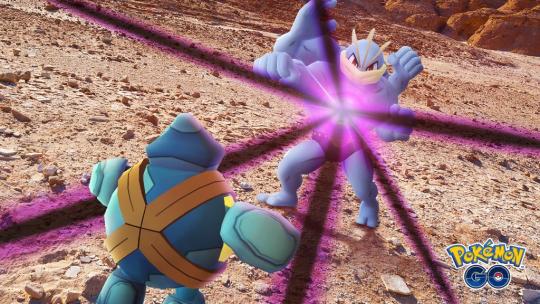
View On WordPress
0 notes
Text
Fluid Post-Modern Neo-Tribes: A Case Study of the West Perth Cheer Squad (Australian Rules Football), 1984-1986- Juniper Publishers
Juniper Publishers- Journal of Physical Fitness, Medicine & Treatment in Sports
General Introduction
In this article I apply Gary Armstrong’s [1] anthropological approach to soccer (i.e. association football) hooliganism studies to our 20-person West Perth cheer squad (hard-core supporter group) of 1984-86 (Australian Rules football’s WAFL competition). I find that the anthropological approach is able to explain many aspects of our cheer squad’s culture and members’ behaviours including the quick disintegration of the cheer squad early in the 1986 season without anyone officially ending it. However, our group members did not adjust their commitment downwards during the cheer squad’s years of action; most members attended all home-and-away matches during May 1984 - March 1986.
West Perth FC has been a foundation member of the Perth-based Western Australian Football League (WAFL) competition since 1885. However, the WAFL was reduced to second-tier status when the newly-formed Perth-based West Coast Eagles club entered the expanded Victorian Football League (VFL) (now Australian Football League (AFL)) in time for the 1987 season [2]. The VFL/AFL now operates as a de facto national premier league (first division). As in American professional sport, there is no promotion to or relegation from the VFL/AFL to the various second-tier leagues based in each of the major cities. During the twentieth century, up to 1982, the VFL/AFL was based solely in the state of Victoria (and 11 of its then 12 clubs were based in the city of Melbourne).
A cheer squad (an Australian Rules football term) is a semi-organized group of hard-core supporters (comprising typically but not always a male teenager majority) which sits in the same strategic place at home matches and which supports the team through chants, songs, flags, and banners1. However, traditionally, cheer squads did not sing or chant continuously but only at significant moments in the match such as when the team runs out on to the field and after goals (which are far more numerous in Australian Rules than in soccer). Unlike soccer ultras, the groups generally did not stand in circles singing and chanting at off-stadium locations such as pubs or railway stations. This ultras-style behaviour may be infiltrating cheer squad culture so we must be careful to restrict ourselves in this article to discussing the cheer squads of the eighties. (Since 1989 the national soccer league has been played in summer so it is possible and not uncommon for supporters to support an Australian Rules club and a soccer club and the supporters of both sports are likely to be the ones who have been bringing ultras’ culture into Australian Rules. For example, leading members of the South Fremantle Cheer Squad (WAFL), formed 2002, also attend Perth Glory soccer matches in the summer.) A cheer squad typically attends some or all away matches, and usually sits in a humble location at away venues (near the entrance which is closest to the train station for example) and rarely tries to take over the home cheer squad’s territory2. Australian Rules football cheer squads should not be confused with the cheer squads of American Football which are, obviously, completely different.
Foot Note
1Some of these cheer squads (such as the cheer squad at WAFL club East Perth from 1982-88, according to David Lockhart) were club-sponsored and financed (source for information on East Perth Cheer Squad: comment by David Lockhart on Lost WAFL Facebook page, 4 December 2013). Others, such as our West Perth Cheer Squad, were unofficial only and had no official connection to the football club.
The dominant culture at Melbourne- and Adelaide-based cheer squads, since the formation of the first cheer squad at VFL/AFL club Richmond in 1959 [3], has included an important fraternal ethos among rival cheer squad members especially away from the grounds. The cheer squads took on some of the “illusion of violence” [4] or tough-guy posturing from British and European soccer hooligans and ultras. However, this was more in terms of style and posturing; cheer squads rarely sought out or engaged in actual violent actions. Another influence on the cheer squads arguably was the ultras groups formed by Australian soccer supporters from European ethnic immigrant backgrounds including those connected to clubs such as Melbourne Croatia, South Melbourne Hellas, Sydney Croatia, and Sydney Olympic [5].
Aim
The aim of this article is to apply Armstrong’s theory of fluid “post-modern” “neo-tribes” [1] to our West Perth cheer squad 1984-86 and draw appropriate theoretically-informed conclusions from this application. We also use Peter Marsh’s concept of “aggro” as the “illusion of violence” [4] which suggests that, in order to gain and demonstrate control over territory and resources, rival groups engage in symbolic behaviours (advances and retreats) which more often than not involve only mild violence or no violence at all. If group self-respect, integrity, and territorial control can be achieved without actual violence then, as the theory goes, so much the better.
Motivations
It is important to study the behaviours and cultures of Australian Rules football hard-core supporters and cheer squads as this has been an under-researched area. Much of what we do know to date comes largely from personal memories and anecdotes and from occasional comments and digressions in Australian Rules football history books of various kinds [6].
Background
General Background
The three largest population centres where Australian Rules football is the most popular winter sport are Melbourne, Adelaide, and Perth. Traditionally the Melbourne-based VFL/ AFL competition had and has the best football, the largest crowds, and the most passionate supporters compared to the local competitions based in the other two cities (the SANFL in Adelaide and the WAFL in Perth). Football supporter culture has typically diffused from Melbourne to Adelaide (654kilometres to the west) and, only to a much lesser extent and at a slower rate, from these two centres to Perth. Slow diffusion to Perth is largely due to distance: Perth is located far away on the country’s west coast 2,131kilometres from Adelaide and 2,721kilometres from Melbourne. Until recently working-class and lower middle-class people rarely travelled from Perth to Melbourne but travel from Adelaide to Melbourne was much more common due to the fact that it was within easy over-night driving distance. As a result seventies’ and eighties’ football supporter culture diffused faster and to a greater extent from Melbourne to Adelaide than from these two cities to Perth.
In the peak cheer squad years of the VFL/AFL in the seventies and eighties, when it was a Melbourne suburban competition plus Geelong FC, cheer squad members from various clubs would catch up with each other after games at Flinders Street Station and shout across station platforms the scores from their respective grounds. There was also a place called Classic Cafe in Melbourne city-centre where cheer squad members congregated and interacted on Saturday nights after the regular Saturday afternoon home-and-away games [6]. If anything, cheer squad members have been less violent than ordinary supporters of Australian Rules’ clubs. A distinction has been made between the inner and outer cheer squads at the popular Collingwood club where the inner cheer squad was the approved membership that adhered to fraternal cheer squad ethics whereas the outer cheer squad was the hooligan element not under the restraining influence of cheer squad leaders. However, I argue that, despite this, the “illusion of violence” has always been important, to some extent, for Melbourne- and Adelaide-based cheer squads.
The fraternal Melbourne- and Adelaide-based cheer squad culture merged with the outwardly more aggressive English soccer hooligan culture, which regularly appeared on Australian TV news reports, to create the ethos of groups such as our West Perth Cheer Squad. Growing up as teenagers in Australia in the eighties we all saw the TV news reports of soccer hooligan violence coming out of the UK and, being eager to prove our credentials, we adopted some of their tough-guy posturing or “illusion of violence” [4]; the influence was there definitely at the subconscious level if not at the conscious level. So to say that Australian Rules football crowds and soccer crowds are unrelated topics is simply nonsense. However, we never initiated violence and we were only once seriously threatened by it (at Bassendean Oval). The events of that particular day will be presented and analysed in the Results sections of this article.
Foot Note
The leading cheer squads in WAFL (Perth-based) football in 1984-86 were Perth Demons, Claremont, Subiaco, West Perth, and East Perth, probably in that order or with West Perth as third. None of the remaining three WAFL clubs had semi-organized cheer squads of any type as far as key people were aware. Perth and Claremont might have had 20-30 people on a good day, and our West Perth group had a stable core of 15-20. By the second half of our existence we had around 15 large red-and-blue flags or one flag per core member.
West Perth in fact had three cheer squads during the 1984- 86 periods:
a) Fat Pam (Pam Hynsen)’s cheer squad, which disbanded at the end of the 1983 season but continued to still make the banners the players ran through before the games;
b) Our unofficial group situated behind the northern-end goals, which replaced Fat Pam’s group which had formerly used that location; and
c) The Grandstand Falcons, a group of older guys then in their twenties who sat at the top of the Leederville Oval grandstand and sang songs (but had no flags or floggers).
The existence of three supporter groups shows the passion and commitment of grassroots supporters for many of the WAFL clubs during the eighties when average match attendances for home-and-away fixtures were around seven to eight thousand.
At one Subiaco Oval (neutral-venue) game, our cheer squad sat in front of the Grandstand Falcons with a third section of seats in front of our cheer squad reserved for our flags and banners. (Our group never took floggers to away games but instead we stored them in the West Perth FC club facilities at Leederville Oval.) Altogether there would have been over 50 people there that day across both groups combined. The noise the combined group made under the grandstand roof, on the second- (middle-) tier of the three-tier stand behind the Fremantle-end goals, was magnificent when magnified by the echoes. We sang the Grandstand Falcons’ powerful song “This Time, We’ll Get It Right3 about England’s 1982 World Cup hopes (with England changed to West Perth and the “white” dropped from “red, white, and blue”). This song summed up perfectly people’s emotions at the time because it had been a decade since West Perth had last won a premiership [7] and the supporters’ hopes had been dashed on many an occasion. In hindsight, this was our cheer squad’s greatest day.
The largest and best organized cheer squad was Perth Football Club’s under the leadership of a very warm, cheerful, and sophisticated “metro-sexual” guy with blond-rinse hair called Nick. Nick brought the disciplined and fraternal Melbourne-based (VFL/AFL) cheer squad culture and ethics over to the Perth Football Club. This cheer squad had existed since at least 1981. To this day the wooden bench seats behind the northern- or city-end goals at Lathlain Park, Perth’s home ground, are painted red-and-black, a permanent reminder of the days (and years) when Nick’s passionate cheer squad occupied those benches.
The Claremont cheer squad was probably similarly influenced by the Melbourne-based cheer squads since one of its core members wore a Melbourne-style duffel coat with club name and favourite player name and number (Peter 15 Jamieson) emblazoned on the back in big iron-on lettering. The duffelcoat culture never caught on in Perth as, unlike in Adelaide, few school-aged Perth-based supporters then made trips to Melbourne or Adelaide to watch VFL/AFL or SANFL games, and the only places to see the duffel-coat culture were Melbourne and Adelaide. Furthermore, the Perth winter is milder and too hot for duffel coats.
These duffel coats were excellent for standing on the terraces in the rain on Saturday afternoons in Melbourne because the rain-soaked coats could simply be left out to dry and would be wearable one week later. It was common in 1982 to see these duffel-coats with team and player names ironed on and pinon player badges being worn on the streets by teenagers on weekdays in the city-centre. However, by 1986, the coats were mostly only being worn at games while by the nineties they had disappeared from the stadiums as well. All-seater stadiums with covered roof sections had made them redundant.
Fat Pam’s West Perth Cheer Squad (Disbanded 1983)
I had become aware, early in the 1984 season that the earlier famed West Perth Cheer Squad, which had congregated behind the northern-end goals at Leederville for many years, had quit completely at the end of 1983. This cheer squad was interesting as unlike most cheer squads in Australian Rules’ history in Melbourne, Adelaide, and Perth it was dominated by middleaged females and young children. The legendary leader of this group was a woman known by the woefully politically incorrect moniker of “Fat Pam” (real name: Pam Hynsen)4. The leading women used to stand upright on the last row of wooden benches behind the northern-end goals5. Their cheer squad was large, committed, and dedicated; it had a huge collection of flags and floggers6. This group had operated for a number of years and was well known and respected. I sat near the group at the northernend of East Fremantle Oval for an East Fremantle versus West Perth match in Round 17 (8 August) 19817.
Foot Note
3See: https://www.youtube.com/watch?v=2w3_PZh0IR4 [accessed 14 September 2017]. 4Pam’s family name was supplied many years later in a comment post by long-term cheer squad member David Barr on the Facebook page Lost WAFL on 21 September 2017. This comment post appears to have been deleted.
However, with Fat Pam’s cheer squad disbanded, I sensed a gap and an opportunity. As far as I was aware, in May 1984, Fat Pam’s group continued to make the banners that the players ran through at the start of each game (they may still make these banners today), and our group never attempted to get involved in this activity, mostly out of respect for Fat Pam’s group which had been there long before it. The northern-end at Leederville Oval in 1984 was strangely quiet, empty, and barren, now devoid of West Perth flags and floggers on home match days. I felt that the team would be inspired by a vocal group of home supporters, with a colourful red-and-blue visual presence, at the northernend of Leederville. A Melbourne Knights’ soccer supporter puts forward her view (below) that her team has been inspired and encouraged on occasion by the vociferous, noisy, and colourful support of the club’s hooligan firm Melbourne Croatia Fans or MCF:
“From what I can gather, the MCF is largely made up of young men who are passionate about their club, its heritage and its importance to the Croatian community. They are loyally devoted to their team and will often travel great distances in order to show their support. The songs, chants and banners have (according to the players) been known to lift our team in crucial moments during the match”8.
I was inspired to set up a new unofficial cheer squad to replace Fat Pam’s group behind the northern-end goals at home matches and to travel to select away games. I expected that the demographics of my new group would be totally different to Fat Pam’s group but I hoped that our members would show the same loyalty, dedication, commitment, and spirit. The new cheer squad would have a lot to live up to.
West Perth versus South Fremantle, Leederville Oval, Round 6 (5 May), 1984
My high-school friend Mike B (also a West Perth supporter) was willing and interested in the cheer squad idea so, on Saturday 5 May 1984, we took the Number 105 bus from Booragoon into Perth city-centre, walked two blocks from St George’s Terrace to Barrack Street (just north of Murray Street), and then caught the 1.15pm Number 15 bus to Glendalough. Mike B and I then alighted near the ground along the Oxford Street cappuccino strip, not far from the corner with Vincent Street. I am fairly sure that Mike B and I already had two large red-and-blue homemade flags on this day. On this day Mike B and I both wore long-sleeved West Perth replica playing jerseys. Although these were not the height of fashion even in the mid-eighties Mike B and I were both proud to show off our club loyalties.
Contemporaneous newspaper reports confirm that this match was the thrilling home draw against South Fremantle on 5 May 1984 described by Atkinson [7] in his West Perth FC official history book. Atkinson recounts that the slender Aboriginal forward flanker Ron Davis9 kicked two goals out of three for West Perth in the last five minutes to draw the game with only 15 seconds remaining. The final score was: West Perth 15.15 (105) drew South Fremantle 16.9 (105) (source: match scores are taken from ibid., p. 334; The West Australian, Monday, 7 May, 1984, p. 81) and the official attendance was 7,790 (source: WAFL Online website). I certainly do remember a joyous mood that day commensurate with an exciting come-from-behind draw. It was the perfect on-field start to begin the cheer squad era. It was the first drawn match in the WAFL since 20 April 1974.
Mike B and I must have exerted an aura of charm and authenticity on this day as a number of people came up to us, introduced themselves, and stayed for the rest of the afternoon including Courtney; Rohan H; and Mark T aka “Thommo”. Some of these people, including the three names mentioned, would go on to become core members of the cheer squad.
Courtney, 14-years-old, from Carine, friend of Rohan and Thommo
Blond 14-year-old Courtney was a designer dresser in the manner of the English “soccer casuals” of the eighties. He was very interested in fashion. I think that he also had a longsleeved West Perth replica jersey but, other than that somewhat unfashionable item of clothing, he always wore colourful veeneck woollen jumpers (pullovers); bulky cargo shorts (even on the coldest days); and navy deck shoes without socks. Courtney came from a middle-class or upper middle-class family suburb in WPFC’s geographic district10. It was most likely Carine which is today part of Subiaco FC’s recruiting zone11.
FootNote
5 The word “goals” is used in plural form in Australian Rules football culture because the goals are made up of four separate vertical posts.
6 Fat Pam’s cheer squad can be seen on the video-clip of the 7 May 1983 West Perth versus Subiaco game recently posted to YouTube.com. The cheer squad is at far left of screen (behind the Leederville Oval northern-end goals). To find this video search YouTube for “West Perth v Subiaco 1983” or simply copy-paste the following link into your browser: http://www.youtube.com/watch?v=3gmZMzTr7CA&feature=related [accessed 7 August 2011].
7 Two pictures of Fat Pam’s WPFC cheer squad at East Fremantle Oval on 8 August 1981 can be viewed at the following link: http://waflgoldenera. blogspot.com/2013/12/picture-gallery-fat-pams-west-perth.html [accessed 5 December 2013].
8 Melbourne Knights’ supporter, personal e-mail communication to the author dated 23 August 2010.
9 Ron (Ronald Brian) Davis (DOB 11/8/1963) played 13 senior games for West Perth in 1984-85 and kicked 22 goals (Atkinson, 2008, p. 354).
10 The creation of allocated zones within the metropolitan area for each WAFL club was introduced c. 1970.
11 For the location of the suburb Carine within Subiaco FC’s recruiting zone as at 2009 see the metropolitan area maps at the following link: https://www. bigfooty.com/forum/threads/wafl-zoning-and-expansion.1085307/ [accessed 16 February 2018].
Rohan H, 14-years, from Carine, Courtney’s Friend: Brown-haired, 14-year-old Rohan H was a slender, quiet lad who stuck close to Courtney. They were school-friends in the northern suburbs and both were committed to the group from the first match. I can’t say that I ever got to know Rohan well. His manner was aloof and unapproachable, but this was not due to arrogance; more likely it was because of shyness and caution. Rohan was very much an introvert but he showed his commitment to the group by his regular attendance for two years. Courtney and Rohan were together the “middle-class” and the relatively more self-controlled sub-gang within the core but they also enjoyed the more boisterous chants and songs.
Mark T aka “Thommo”, 14-Years-Old, “Floater” / Non- Aligned, Courtney’s Junior Football Friend: The next character I will introduce to readers is the redhead “Thommo”, always known to the group members by the nickname of “Thommo” which he brought into the group from his home-suburb and high-school. Group members did coin some nicknames within the group. “Half” for the eight-year-old Michael was the best and most famous of these. However, most of the nicknames people naturally brought into the group from outside and it were more authentic and simpler to use these pre-existing names than to invent new ones.
The senior Thommo’s character was complex. He was, like many of the others, a working-class rebel and a very loyal and tough person. He could chat calmly and intelligently with people, but, if he felt that he was being disrespected, then he would change in an instant, and give that person a swift rebuke and stinging defence of himself and of his arguments. In that way people learned to respect him and be slightly wary of his reactions although you could also praise and respect him for his mild-mannered nature, self-control, and good humour. He was great for joking and laughter and he also enjoyed getting analytical at times about West Perth’s players and performances.
Another point to note is that Thommo knew Courtney through junior football although they were not from the same high-school. Thommo then became an important natural link between the various sub-gangs in the group. His background, dressing, and style were more proletarian than those of the “Carine group”, Courtney and Rohan. However, the link between Thommo and “the Carine group” was important and a part of the glue that reinforced trust and goodwill especially in those early weeks in 1984 when group members did not know each other well.
Cheer squad members all used to stay behind after games until well after darkness on the playing surface of Leederville Oval and away venues to kick footballs amongst themselves. Thommo, in these encounters, was a fast, courageous, and skilful footballer. He would contest marks against the immobile rock that was Peter “PA” Brennan (family name changed) who was sixfeet- two and a veritable 18-year-old man mountain. PA would stand in one place to mark and kick whilst Thommo and the others would use their speed and skill to steal the marks from PA, either in front or to the side of him, or else they would pick up the loose balls that P.A. spilled. I can remember Thommo’s habitual long-sleeved checked flannel shirts, later made famous in the grunge music era of the early-nineties, and how he would always have a cigarette packet in his chest pocket which would often fall to the ground whilst he was running at or with the football. He would then quickly run back to recover his cigarette packet from the ground in order to beat any potential “thieves”. Group members stuck with their own group in these football games, and would never formally join in with strangers. This is perhaps further evidence for the proposition that the cheer squad was a “group-for-itself” (see Results section).
Michael aka “Half”, 8-Years-Old, from Bayswater
I now move on to mention the group’s most important and famous younger member, Michael, or “Half” as the group members christened him because he was one-half the height of the other people in the group. Half was a sandy-haired eightyear- old whose parents were financial members of the West Perth Football Club. They sat in the grandstand at home games and attended all away games. They allowed Half to set his own agenda, go his own way, and make his own friends during the games as long as he did not leave the enclosed confines of the grounds. That was an era where people generally let their children roam free and people were less conscious of the threat of paedophiles. His parents were never seen by the group members but I suppose that group members viewed them as spectral support from the more respectable section of the West Perth supporter base. They attended all games home and away. Certainly they gave the group a certain amount of trust and group members did feel some obligation and responsibility regarding Half’s welfare. Half was a very passionate West Perth supporter although I believe he lived in the East Perth FC geographic district in either Bayswater or Maylands.
Half joined the cheer squad for every home and away game for two years and he always joined group members on the playing surface after games for the informal kick-to-kick sessions among the group members. He was always regarded as an important part of the cheer squad and his nickname was a sign of affection. He was a carefree extrovert who liked chatting and laughing and would get very excited during significant moments of play when West Perth was doing well. At such times he would run around and climb up on to empty seats, waving his flag furiously. He would enjoy the insulting cheer squad chants and enjoy negative discussions about other teams and verbally jousting with rival fans of his own age if any of them came too close. Like every group member, he genuinely loved and admired the playing group, the team, and the club but in the innocent way you would expect of an eight-year-old. When he urinated on the oval during kick-to-kick sessions he would receive a rebuke from other members who would quickly look away!
Once I recall telephoning half’s house to discuss with him tickets relating to either the Sandover Medal Night, at the now
demolished Perth Entertainment Centre in 1984, or to the first semi-final of 1985. I recall Half’s father answering the phone and being very wary initially. However, when he heard that I was from “West Perth cheer squad”, he totally relaxed, and he handed the phone over to Half. I arranged with Half for the buying of his ticket in conjunction with his father. Half could be quite mature in discussing things such as buying tickets to events. He certainly did not want to miss out on anything. Overall Half was an extremely interesting character and almost the cute and cheeky mascot of the cheer squad.
“P.A.” and Dave S, 18-Years-Old and 16-Years-Old, the Balga Sub-Gang
My personal 1984 WAFL season notes, compiled during the 1984 season, state that Peter “PA” Brennan (family name changed) (hereafter “PA”) and Dave S (name changed) first joined the group for the Round 12 (23 June) 1984 match when West Perth defeated Claremont 21.10 (136) to 9.14 (68) at Subiaco Oval (source: match scores taken from Atkinson [7]). Although at that time PA and DS were regarded by group members as being the “Balga group”12 DS was actually from Tuart Hill as he confirmed via a since self-deleted comment he posted on the WAFL Golden Era website (waflgoldenera.blogspot.com) on 14 June 2013. PA and DS together made an interesting spectacle, and I do remember that it was with great interest and some anxiety that group members watched the pair walk towards us on the first day. PA was six-feet-two, stocky, and built like a country league football ruckman (or like ruckman Ron Boucher of the Swan Districts Football Club) whereas DS was much shorter and quite slim.
DS, the cheer squad’s only Asian member, was an ethnic Chinese who also, from day one, wore the “uniform” of longsleeved West Perth replica playing jersey and plain blue or black jeans (the most popular dressing style in the cheer squad). He was first seen with PA before they joined the group, and he also was associated with the “Balga group” although he came from Tuart Hill. He was also an interesting character and he had a love-hate relationship with PA that involved frequent insults directed at PA’s alleged gullibility.
An interesting coincidence was that West Perth’s then league-team captain and one of the club’s greatest ever players was Les Fong, a Chinese-Australian who was nicknamed “Chopsticks”, “Choppy” or “Chopper”, and then the cheer squad had its own Chinese member in DS Perhaps Les Fong’s presence at West Perth made it easier for the cheer squad members to accept DS. Their actual real names in fact rhymed and had only two different letters out of seven. Group members regarded it as interesting, symmetrical, and appropriate that the cheer squad had its own Chinese member. It meant that the West Perth senior team had its mirror image, in terms of ethnic mix, on the other side of the playing fence.
I cannot remember DS facing any racism that was hostile from any of the cheer squad’s core members but of course he may have experienced some teasing and put-downs. As with Thommo, DS had a very well-developed self-defence mechanism so people knew where they could stray verbally and where they could not. DS must have enjoyed cheer squad membership or he would not have stayed with us for two years. He was also a very faithful member even though he could never have been described as warm or even as friendly much of the time. He could also vary significantly in temperament and mood from week to week so on some weeks he might greet you warmly while on other weeks he might ignore a greeting. People had to work hard to earn his respect although he probably respected all or most of the cheer squad members, to some certain basic extent, if his continued attendance at games with the cheer squad was any indication. Of course people learned to expect DS’s mood changes and to live with them.
One of DS’s strong points, other than his loyalty to the cheer squad, was that he would often laugh at the humour being shared around, and his face would sometimes light up in a wide and magnificent smile. If DS wanted to discuss something serious, he would come up very close to you, remove his black sunglasses, and quietly and carefully make his points. The removal of the “sunnies” was the sign of his respect and the seriousness of his point. DS loved the actual sport of Australian Rules more than most fans; watched each game pan out with eagle eyes; and he would rebuke people who made what he considered to be unnecessary noise. Sometimes the joking would set off among five or six group members. PA would double up, bend down lower, and emit loud laughs. DS would rarely laugh but he would have this wide smile while his eyes remained intently focused on the game. These were some of the better moments of the cheer squad. DS clearly had a strong bond with PA that appeared to pre-date the day on which PA and DS first joined the cheer squad. The way the cheer squad worked was to honour and respect, and to some extent even to trust, these pre-existing bonds that people brought into the group from their home-suburbs and high-schools.
Mike C and Pete C, 16-Years-Old and 14-Years-Old, No Fixed Abode
The brothers Mike C and Pete C were an integral part of the cheer squad from very early on. Cheer squad members knew that both had a background of reform and foster homes, but no-one ever thought that either would steal anything from the group members or anything similar. Mike C could find it hard to control his emotions, whether anger or excitement, so group members assumed his troubles with the police had related in some way to this. No-one ever asked him what his troubles had been. Pete C once said that Mike “hated pigs” and no-one found this hard to believe. Cheer squad members adopted the “don’t ask, don’t tell” policy.
FootNote
12 For the location of the suburb Balga (traditionally regarded as West Perth territory) within Subiaco FC’s recruiting zone as at 2009 see the metropolitan area maps at the following link: https://www.bigfooty.com/forum/threads/wafl-zoning-and-expansion.1085307/ [accessed 16 February 2018].
Mike C (16-years-old) was a scary sight to people that didn’t know him and even to some of those who did. When he got excited by the football he would walk straight up to someone in the group, stand right in front of him, and totally invade his personal space, without seemingly being aware of it. He would also do this when greeting someone for the first time each match-day. His big green eyes got fiery when excited and, in his muscle tee-shirts of the eighties and his long, thick, black, wavy hair, he cut a scary figure, and he was a vital part of the group’s tough-guy image. Under his replica West Perth playing jersey, Mike C would wear short-sleeved muscle tee-shirts, in bright colours, made famous by Australian rock stars of the era such as Cold Chisel’s Jimmy Barnes and AC/DC’s Bon Scott and Malcolm Young (6 January 1953 - 18 November 2017). Mike C. was at his most boisterous on West Perth’s good days when he would loudly and gleefully start and continue chants and songs. Mike C. was completely unafraid of opposing supporters, enjoyed loudly and conspicuously “invading” opposing team’s grounds, especially at Bassendean Oval, and he could become oblivious to place and context. Only the eight-year-old Michael aka “Half” was as openly boisterous as Mike C. When excited, both individuals would cover large amounts of space in and near the cheer squad’s chosen area, standing on and leaping over seats and waving flags and chanting.
Pete C (14-years-old) was a complete contrast to Mike C: short, quiet, softly spoken, polite, thoughtful, gentle, analytical yet equally loyal - to his brother, to the cheer squad, and to the WPFC. He was one of the people whom I most enjoyed talking to. As with his brother, his standard match-day “bogan”13 attire was long-sleeved West Perth replica jersey, tight blue or black jeans, and sneakers. Both the brothers were fiercely loyal to each other and, of course, this fact and the underlying attitude behind it were very helpful to the cheer squad. Group members all valued the brothers’ loyalty, warmth, and dedication to each other, to the group, and to West Perth. The C brothers, along with Thommo and Robbie, gave the group much of its “illusion of violence” and the hooligan look and attitude. Group members knew that the C brothers had no fixed abode and lived hand-tomouth, and the group members thrived on this knowledge; it gave the cheer squad a working-class tough-guy persona that it might otherwise have lacked.
Go to
Literature Review
General Introduction
Dunning et al. [8] outline the main academic approaches to soccer hooliganism studies used by academic researchers. The academic theories can be divided into: The early-dominant “figurational” or “process-sociological” approach of Dunning et al. [9,10]; the “anthropological” approach of Armstrong and Harris [1,11]; the post-modern approach of Giulianotti; the Marxist approach of Taylor, Clarke, and Hargreaves; the “ethogenic” approach of Marsh [4]; the “psychological reversal theory” approach of Kerr; and the historically sensitive / historical approaches of King and Robson [8]. We rely predominantly on Armstrong’s anthropological approach while hoping to gain insight from all of the relevant theories (including Marsh’s theory of “aggro” as being “the illusion of violence”).
Fluid “Post-Modern” “Neo-Tribes” (Armstrong and Hughson)
Next I move on to review the ethnographic academic research on hooliganism that began in the nineties with two landmark PhD theses, one in the UK by Gary Armstrong on Sheffield United’s Blades hooligan firm (later published as Football Hooligans – Knowing the Score) and one in Australia by John Hughson on Sydney United’s Bad Blue Boys National Soccer league (NSL) firm from the early-nineties. Subsequent articles by Hughson [12-16] synthesize key findings of these two studies and relate some of Armstrong’s key findings to the unique context of south-west Sydney’s Bad Blue Boys (BBB), a group of Croatian-Australian teenagers who are, or perhaps were, hardcore supporters of the former NSL’s Sydney Croatia club (which was renamed Sydney United in the nineties). It should be pointed out that these “anthropological” authors have been criticized on a number of grounds by other academic researchers. Armstrong [1] has also criticized the early-dominant Leicester University School approach of Dunning and Williams.
Using the anthropological approach, Armstrong [1] focuses on the disorganized nature of Sheffield United’s Blades’ firm and the fluidity of group membership. People come to and go from the Blades according to the needs of their lives at particular stages and no-one is ever “bound” to the Blades in any sense. People connected with the Blades acknowledge that hooliganism is an acquired taste and a profession at the edge of even hardcore fan support [17]. Armstrong [1] talks in terms of fluid “postmodern” “neo-tribes” and this terminology and its associated logic is taken up by Hughson in his ethnographic study of Sydney United’s BBB.
Foot Note
13 Bogan was a youth sub-cultural term used only in Australia. It referred to long-haired football and heavy-metal music fans who would dress in tight jeans; tight tee-shirts (usually black); long-sleeved checked flannel shirts with sleeves rolled up; and black desert boots (referred to as DBs in Perth). They usually were associated with those lower socio-economic suburbs of the major cities which were located some distance away from the ocean. (In seaside suburbs surfer culture was influential.) In the popular imagination they were often counterpoised to both surfers and British-immigrant skinheads. Their favourite bands tended to be AC/DC, Rose Tattoo, and Iron Maiden.
Armstrong [1] points out that firm allegiance is bounded and held in tight check. It is generally subordinated to ordinary relationships so that a Blades member would put to one side (or suppress) his / her hostility towards Sheffield Wednesday’s “Owls” hooligans when relating in the normal way to friends, family members, and work colleagues. When Blades and Owls meet outside of match days the context is often ambiguous and people have to determine whether this is a “soccer context”14 where fighting is justified or not. When groups of Blades or Owls invade each other’s pubs on London Road or West Street on a Friday night this is a soccer context whereas if Blades or Owls are socializing with women or with non-hooligan mates this is not a soccer context and so soccer-related violence is unacceptable.
Significantly, neither Blades nor Owls members meet frequently outside of soccer seasons because such meetings are ambiguous and hard to interpret as being soccer-related. Armstrong [1] writes as follows: [T]he raison d’être of the Blades was a football [soccer] match, and a collective identity more or less died outside the football season, to be resurrected at the early August pre-season friendly games”. On the other hand, it was possible for the Blades’ collective identity to assert itself as dominant at gatherings outside of the soccer season such as a marriage celebration and a 30th-birthday celebration. Armstrong [1] states as follows: “Blade identity could therefore be automatically sustained away from the club and the match in other contexts that did not need a game of football [nor even the football season]”.
Likewise, our West Perth Cheer Squad 1984-86 met only once outside of football seasons - when Mike C, his younger brother Pete C, and I arranged to attend a one-day domestic cricket match at the WACA Ground. However, this was early in the cricket season (October or November) and the planning to meet took place at the last West Perth football game. In effect, this cricket match can be seen as a special one-day extension of the football season.
Armstrong [1] ends his book by describing how Blades would sometimes in 1997 watch games at pubs close to the Bramall Lane ground partly as a protest against rising ticket prices. This is the beginning of, in Armstrong’s words, “post-fan” behaviour. Armstrong’s data ends in 1997 and so we do not how the Blades are functioning in the new millennium. Generally rising season ticket prices and the rising cost of train travel have meant that the demographic of soccer support in the UK has changed while improved policing methods are a further factor in creating disinterest in hooliganism.
Armstrong [1] produces very interesting data in the form of a list compiled in April 1987 of 190 Blades with ages, occupations, and criminal record (if any) listed. He classifies these into subgangs and, as with our West Perth Cheer Squad (Appendix A for a list of West Perth Cheer Squad sub-gangs), some sub-gangs might have had as few as two or three members. Larger sub-gangs which were part of the Blades included Old Lads; Drug Squad; Suicide Squad; Max’s Coach Blades; Villagers; and Rotherham Blades. These last two groups were the most obviously separate since their outside-of-Sheffield locations influenced how they viewed themselves, other Blades, and other firms, and also influenced their willingness to fight. They felt that certain City Blades were too close to certain City Owls and hence sometimes not willing to confront them. Clearly, the out-of-Sheffield Blades were more idealistic and less pragmatic than the City Blades. The present article follows Armstrong’s [1] example. Appendix A lists our West Perth Cheer Squad’s sub-gangs and the members belonging to each.
Armstrong [1] emphasizes the casual nature of group ties and the recognition that a person was not morally bound to the firm in any way if he / she decided to give up soccer fandom or give up hooliganism as part of a natural evolution within his / her own personal life. Some people might “come out of retirement” for big matches against the Owls or if a confrontation came to them. They would often continue to go to games and London Road Friday night pub sessions but sit with non-hooligan mates or sit with Blades but not leave the pub (bar) to meet a challenge from outside.
Generally, Hughson’s research of BBB supports this. He tells the humorous example of one Croatian-Australian hooligan with his girlfriend being ridiculed by the group for his love interest to the extent that over time he, and others in similar positions, disappeared to the fringes of the group or left it entirely. This hooligan was taunted by the Croatian word for “slippers” which signifies domestic bliss and a certain married lifestyle.
Go to
Research Method
This is an ethnographic study of the West Perth Cheer Squad 1984-86 told from my viewpoint as co-founder and co-leader of this group alongside my then school-friend Mike B. It is both strength and a weakness of the research data that I was an active participant in events rather than a researcher performing typical ethnographic research ex-ante as a non-participant. I rely upon
a) Personal memories backed up by;
b) Newspaper reports from the era;
c) Official club history books for West Perth and Swan Districts;
d) My personal 1984 season notes which were handwritten by me during 1984;
e) A personal interview with Mike B conducted in person in Kalgoorlie, Australia on 14 July 2011 and since then by personal online communications;
Foot Note
14 Armstrong uses the word “football” but we prefer to use “soccer” because of the Australian setting of our data.
f) Several long online conversations during the course of calendar year 2017 with ex-cheer squad member Ben McAuliffe; and
g) Posts from older supporters on the Facebook page Lost WAFL and in the Facebook group Say NO to any AFL Clubs in the WAFL. During the cheer squad era, Ben McAuliffe was aged 13-15 and attended John XXIII (Roman Catholic) College in Perth (Appendix A).
Both Mike and Ben read through first-draft copies of my book (which is the extended version of this article) and Ben corrected three errors:
a) I had forgotten and left out his friend Rob who had attended Perth Modern SHS in the cheer squad era;
b) the Italian brothers Tony and Mario (whom Ben remembered) had attended Perth Modern SHS with Rob and not Churchlands SHS as I had earlier believed; and
c) Ben himself had attended John XXIII College rather than either Perth Modern or Churchlands (although he was a friend of Rob’s at the time).
Apart from DS, who would not take up my offer to correspond with him online after I saw his post on the WAFL Golden Era website in 2013, most of the other cheer squad members were and are impossible to contact since I never knew their full names back in the eighties15. In the case of some of the others, their full names were and are simply too common to track them down in a city of two million people (i.e. modern-day Perth).
Go to
Results
The Cheer Squad as Fluid “Post-Modern” “Neo-Tribe”
Generally speaking the West Perth Cheer Squad conforms to the idea of fluid “post-modern” “neo-tribes” where affiliations are very loose and people can easily adjust their degrees of commitment to a group and / or leave the group when their personal priorities and interests change [1,12-16]. Hughson indicates that few people remained integral parts of soccer hooligan firms in the UK beyond their early-twenties although Cass Pennant and Rob Silvester suggest that Millwall’s Bushwackers firm was probably an exception in this regard [18- 20]. Armstrong [1] writes that by the 1980s the “vast majority of Blades were aged between seventeen and twenty-eight”.
As with Sheffield United’s Blades hooligans, people recognized that joining the West Perth Cheer Squad was totally voluntary, without any of the legal and economic ties that define workplace, marketplace, and institutional relationships. As such, the group was always careful not to “invade” another member’s outside life, i.e. his life at home, school or work. Group members rarely contacted each other by telephone or met during the week outside of Saturday match-days. Group members only met five times outside of match days during the whole 1984-86 period and only once outside of the football season (when Mike C, Pete C, and I attended a season-opening one-day domestic cricket match at the WACA Ground).
Our West Perth Cheer Squad’s experiences in 1984-86 definitely lend credence to Armstrong’s [1] theory about the casual nature of group ties and the fluidity of group membership with telephone calls between our members being rare; members knowing most other members only by first name and / or by nickname; members usually not knowing where other members lived or if they did know they knew only the suburb name; members meeting only five times outside of football match days and only once outside of the football season (the cricket match referred to above); and the group withering and dying of its own accord, without any fanfare, over the first few weeks of the 1986 WAFL season. However, unlike some of the Blades members in Armstrong [1], our group members did not adjust their commitment downwards during the cheer squad’s years of action; most members attended all home-and-away matches during May 1984 - March 1986.
When I stopped going to games during 1986, no-one ever contacted me (and I had been co-founder and co-leader) and when I met ex-member Pete C at Fremantle Oval at a game against South Fremantle late in the 1986 home-and-away season we conversed only as friends and neither of us made any mention (if my memory serves me correctly) of the end of the cheer squad. There was only the two of us; we met by chance rather than by arrangement; and the flags and banners were long gone. We probably avoided discussing the cheer squad’s end as it may have been a sad topic. Possibly people could sense my and key others’ new-found lack of enthusiasm for the cheer squad in 1986 and the infectious zeal that had held the group together for two years simply saw its opposite occur: people drifted away because the igniting zeal had left. Only the zeal for West Perth and for the cheer squad had kept the cheer squad together for two full years and through two complete summer off-seasons (which are six months long in Perth). I admit that my new preoccupation during 1986 was my university studies. In hindsight I wish that I had been slightly more pro-active in extending the life of the cheer squad.
“Group-for-Itself” versus “Group-in-Itself”
Regardless of his background, everyone in the cheer squad was treated and valued equally, and I believe that each group member experienced and enjoyed the camaraderie of the group. Without these positive factors each individual in the core would not have stuck with the cheer squad for two years when there were no legal, economic or moral ties to bind anyone to the group (ibid.). People had to enjoy sitting with the group or the group Regardless of his background, everyone in the cheer squad was treated and valued equally, and I believe that each group member experienced and enjoyed the camaraderie of the group. Without these positive factors each individual in the core would not have stuck with the cheer squad for two years when there were no legal, economic or moral ties to bind anyone to the group (ibid.). People had to enjoy sitting with the group or the group
Foot Note
15 The leaders of the Perth and Claremont cheer squads were and are impossible to contact for the same reason.
Pave Jusup (aged 22 at date of interview), a leader and founding member of the MCF firm at ex-NSL soccer club Melbourne Knights, states consistent with the “loose ties” theory that the only things MCF members have in common are:
a) Attending the games;
b) Drugs and alcohol; and
c) Croatian heritage (source: group interview with the author, Sunshine North, Melbourne, 11 January 2011).
However, he also suggests that the MCF is more organized than the firm at fellow Melbourne-based Croatian club, St Albans Saints (at date of interview it was a Victorian Premier League (VPL) club which is one tier below the national league). The reasoning is that the MCF is organized sufficiently to arrange bus trips interstate whereas St Albans’ supporters are not. In Pave’s words: “[t]he supporters of St Albans are not like us but they [also] do silly stuff. They are not organized like us. We are a proper group. They are just people that turn up at games and sing and drink a lot. We organize time at the pub and away trips”. Our West Perth Cheer Squad lacked the shared ethnic heritage that the MCF has and drugs and alcohol were never part of our cheer squad’s routine. However, at least after the first four or five weeks, the cheer squad was definitely, in Pave’s words, a “proper group” just like the MCF is today. As mentioned, in after-match kick-to-kick sessions and on train journeys back to the citycentre from away venues, we consistently stuck with our core members and almost never joined in with strangers or outside friends. Our group was a “group-for-itself” not just a “groupin- itself” to use these philosophical categories sometimes attributed to Karl Marx.
The Sub-Gangs (Refer to Appendix A for a Full Listing)
If my memory serves me correctly, Courtney and his friend Rohan H both joined the group on the first day. Both were to form part of the core for the next two years with Courtney arguably filling a role as deputy leader, along a second rank, with Rohan H and his suburban junior football friend Thommo (both of whom most probably joined the group on that first day as well). In our group there were tiny sub-gangs following the same pattern, but with smaller numbers, as Sheffield United’s Blades; Portsmouth’s 6.57 Crew; or the Peruvian barras bravas of Lima, South America [21]. The sub-gangs operated along the lines of friendships formed prior to joining the group and suburbs of residence. The sub-groups had two to five people in each, and each sub-group had a particular relationship with the joint-founders, Mike B. and me, and with the group as a whole.
Appendix A lists our sub-gangs and the members belonging to each. Courtney and Rohan (the “Carine group”) was a subgang, as was the “Balga group” of PA and DS. Thommo and Robbie, who joined the cheer squad only in 1985, was viewed as “floaters” or non-aligned. Because Thommo and Robbie knew each other and Thommo knew Courtney prior to anyone joining the group these two floaters were key links between the subgangs. People from the same district were viewed as sub-gangs since they would habitually take the same buses to and from the home games together. (After home games the Balga gang, usually joined by Robbie and perhaps Thommo Senior and his eight-year-old brother Thommo Junior, would head east on foot towards Loftus Street where they would catch their homeward bound bus northwards.)
The Nature of Fan Support within the Cheer Squad
As with the Sheffield United Blades members, the core cheer squad members were all dedicated West Perth supporters and the core members regarded the group as important in their lives and in their match-day experiences of fandom. The core group members were all “traditional” and “hot” supporters based on Richard Giulianotti’s theory of the four types of soccer spectators in the global game, namely “supporters” (traditional, hot); “followers” (traditional, cool); “fans” (consumerist, hot); and “flậneurs” (consumerist, cool) [22,23]. Although Mike B, Courtney, and Rohan engaged in conspicuous consumption in the area of fashionable dressing this consumption did not extend to their football support which remained “traditional” and “hot”. Group members who only occasionally attended games, such as 15-year-old Robert C (brother of Mike C and Pete C and not to be confused with either Ben’s friend Rob or the floater Robbie), might be classified as followers with “traditional” yet “cool” forms of club identification.
Swan Districts versus West Perth, Bassendean Oval, 1985
A trip to Bassendean Oval to play Swan Districts requires a long train journey from the Perth city-centre on the ancient Midland train line. Swan Districts is the most remote from the city-centre of the six traditional WAFL clubs which are not Fremantle-based. (Fremantle is often regarded as a separate city in its own right.) By WAFL standards Bassendean is a fairly compact ground with the outer grassy banks being less wide and less high than those at East Fremantle Oval, Leederville Oval (prior to its recent renovations) or Lathlain Park. Like a soccer ground, all spectators are relatively close to the play. The famous old stands hug the playing arena closely and cast much of it in shadow in the late afternoons.
Since the formation of West Coast Eagles in 1987, “Swans” has had a reputation, fiercely and jealously guarded, of being the epitome of a traditional WAFL club. Bill Walker of Swan Districts was one of only two WAFL club presidents to vote against the entry of West Coast Eagles into the expanded VFL (now AFL). Even the once vibrant Midland and Guildford districts, at the centre of Swan Districts’ geographic heartland, retain a large proportion of historic buildings and they seemed to have remained somewhat shielded from the economic, social, and demographic changes that the rest of Perth has experienced. Bassendean Oval used to be a fearsome place for visiting supporters; every corner of it was “claimed” on match-days by some gang or other of Swans’ supporters16. Even today, Swans attract larger home crowds than other WAFL clubs and the compact nature of the ground makes a crowd of two to three thousand mostly Swans’ supporters still a fearsome proposition for opposition players and fans.
Although there was and is a members’ stand, the R.A. McDonald Stand, in the ground’s south-western corner, has always contained vocal and hard-core Swan Districts’ supporters of all ages. The stand still contains such dedicated supporters today, although nowadays there are empty seats during the main game. In the WAFL’s Golden Era (ending at the end of the 1986 season) patrons had to arrive long before the start of the main game to be assured a seat in the McDonald Stand (pronounced as if it had an extra “s” as in “McDonald’s Stand”). My late maternal grandfather HAA (1906-1999)17 and his mate Ernie Henderson supported Swans and they always sat there, towards the top, in the seventies and into the first half of the eighties. I also sat with them there, on three or four occasions, although never when West Perth was the opponent.
On this most memorable day, most probably in 1985, the West Perth cheer squad headed out to Bassendean Oval, from Perth city-centre on the Midland train line. I cannot recall how many people met in the city-centre beforehand. There was probably a sub-group which got on at the city-centre and the long journey then magnified our good spirits, self-confidence, and camaraderie. West Perth had been performing well on the field in 1985 and a win would certainly not have been an unlikely outcome. The cheer squad was in celebration and party mood, travelling to a distant and remote ground at the far end of the metropolitan area. Many cheer squad members would not have gone to the ground before.
No part of Bassendean Oval is seemingly “reserved” for the away supporters (except perhaps the Bill Walker Stand which is located to the immediate right of the McDonald Stand when viewed from inside the playing arena). The McDonald Stand is only 20- or 30-metres from the southern-end goals. The northern-end goals are furthest from the train station so, logically, that was not the place for the away fans. The logic of the era was that visiting cheer squads (out of humility and respect) would stay nearest the entrance that was closest to the train station or major bus route so that meant, for example, the southern-end at Claremont Oval; the southern-end at Perth Oval; and the northern-end at East Fremantle Oval.
I can recall our West Perth group this day entering what were then the most popular gates of the oval, in the south-west corner closest to Success Hill train station, with our giant flags. In the environment of Bassendean Oval, these flags stood out like a sore thumb. Swans’ fans then had a dour and austere culture where you would not wear club colours. Anything slightly showy was frowned upon as not befitting this working-class district some distance away from the city-centre. Furthermore, Swans’ colours are black-and-white; the cheer squad’s red-and-blue replica playing jerseys and flags stood out like the first year of colour television. People probably thought that we were showoffs and smart-arses. We took the path of least resistance and set ourselves up behind the southern-end goals. The group’s flags and banners were right there in front of the line of sight of the McDonald Stand’s inhabitants some 25-metres away18. The heritage-protected ground is largely unchanged today.
The cheer squad was chanting its usual chants that day but with perhaps unusual venom. There had been animosity between West Perth supporters and Swan Districts’ manager John Todd since Todd left West Perth’s Brian Adamson out of a Western Australian combined state team in 1975 [24]. This animosity had then followed Todd across from East Fremantle to Swan Districts. Dawson writes as follows about the relationship between Swans and West Perth during the 1980s: “The feud was always publicly denied, but continued into the 1980s and all Swans-West Perth games were well-attended with many fiery incidents, off and on the field”. Swans’ record home ground attendance remains today the 22,350 people who watched Swans play West Perth on 10 May 1980 (Round 6) [25].
It may have been our “Ronnie Boucher walks on water / everybody knows that bullshit floats” chant that made the Swan Districts’ fans increasingly upset on this particular day in 1985. Swan Districts had no recognized or organized cheer squad then but generally cheer squads accept each other’s chants as justpart of the job description and not to be taken seriously. The McDonald Stand was an intimidating place in that era and our cheer squad was insulting Swans’ favourite players and showing off its vibrant red-and-blue colours directly in front of their noses. The cheer squad also had its famous song, sung to the tune of the classic children’s song “Old McDonald had a Farm”: “Old McDonald had a stand / eyie eyie oh / and in that stand was full of pigs / eyie eyie oh”. The distant origins of the real Mr. R.A. McDonald19 meant that by 1985 our group clearly intended to insult a revered ancient folklore deity instead of an actual known person. The song was in effect an attack against local gods.
Foot Note
16 Remember that mandatory fan segregation has never existed in the WAFL.
17 H.A.A. had three brothers. Out of the extended family only H.A.A.’s nephew Fred and I supported a team other than Swans with Fred also being a West Perth supporter.
18 The view of the McDonald Stand from the southern-end goals and the opposite view can be viewed at the following link: http://waflgoldenera. blogspot.co.uk/2017/02/opinion-presidents-response-to-todays.html [accessed 14 September 2017].
Around three-quarter time during the main game, we saw that a group of around eight to ten bare-chested Aboriginal youths, around the group members’ ages or slightly older, had very quietly surrounded us and taken up strategic seating positions just outside the group on all three sides. This Aboriginal group began to make intimidating comments including that they would beat us up after the game. The Aboriginal group members wore no club colours but they were clearly Swans’ supporters. They must have been offended by the West Perth flags and chanting. Our West Perth cheer squad watched the game much more diligently and stopped playing up to and taunting the inhabitants of the McDonald Stand. I could tell that our group members were apprehensive. Aboriginal gang culture and the culture of the suburbs around Bassendean Oval were not well known to any of the group. None of us had any reputation in the area that we could call on. It was the classic away fans scenario.
We all began to watch the game much more diligently and talk among ourselves; we adopted a much lower profile. People became grossly absorbed in the match, looked straight ahead, and quietly conversed in their twos and threes. This was partly a strategic act and partly a sub-conscious switch to the selfpreservation mode. The chanting mostly stopped although I am sure that we still waved the flags after West Perth goals.
If we want some theorization of the West Perth cheer squad members’ behavioural self-modifications after being threatened by the Aboriginal group of Swan Districts fans, we might cite Marsh [4] as follows:
“[w]e can instantly recognize dominant or submissive stances in other people and we frequently employ them ourselves ... Adopting a submissive posture is the clearest way in which ... a person ... can signal that he has had enough and thus avoid serious injury”.
When the game ended, or possibly five or ten minutes prior to that, the West Perth cheer squad looked around and we saw that the Aboriginal group had disappeared. I do not think that anyone even saw or heard them leave as they disappeared so quietly. Our West Perth group had passed some kind of test. Possibly the Swan Districts’ group had decided that we were “good guys at heart” or possibly they had just lost interest in confrontation or had somewhere to go straight after the match. Swans’ on-field victory that day might possibly have been seen by the Aboriginal group as having been vindication enough for them (as Mike B today claims (source: personal interview with the author, Kalgoorlie, 14 July 2011)).
Like the London Teddy Boys who menacingly surrounded Desmond Morris and his wife in a Camden Town cafe in 1957 but then paid the couple’s bill and left with a friendly greeting (Morris [26] in the foreword to Marsh’s Aggro), the Swan Districts group had reinforced territorial dominance by Swans’ fans over all of Bassendean Oval, including the seats behind the southern-end goals, without resorting to actual violence. Marsh [4] explains further as follows: “When men enter into aggressive confrontations with each other, the object of the exercise is not killing but preservation of dominance relations, the defence of particular space or access to basic resources”. Some might think that we outnumbered the Aboriginal group and we had the flags with long wooden stick handles which could have could be used as weapons. Therefore, why were we so nervous? However, we must remember that firstly we had a number of 8-12-year-olds present among our number; and secondly that there was also the risk that nearby Swans’ supporters would join in or the Aboriginal group would signal or summon their mates from other parts of the ground to assist them. We took a middle course in that we did not walk away but we did keep quiet and refrained from normal cheer squad behaviour other than waving the flags after goals which was our last symbolic act of resistance and solidarity.
This event at Bassendean Oval’s southern-end goals was a near-miss for the West Perth cheer squad and our group members probably learned a lesson to be somewhat quieter, more respectful, and more circumspect in hostile away territory. It must be pointed out that the cheer squad members never viewed this encounter as any sort of “racial war” - our group was multicultural and we had a multicultural ethos. For example, DS from Tuart Hill was an ethnic Chinese and the brothers Tony and Mario were of Italian ethnicity. In fact West Perth supporters have long been referred to by the racist tag of “Garlic Munchers” (especially by East Perth fans). This tag emerged because of the large southern-European immigrant supporter base which was attracted to the club in the post-World War II period; and especially from the seventies onwards when the Italian- Australian ruck-rover Peter Menaglio was a star player in the senior team20
19 The R.A. McDonald Stand was opened on 23 July 1938, four years after the club was admitted to the WAFL (East, 2009, pp. 21, 87). R.A. (Dick) McDonald was President in the early years of the Swans club and played an important role in the then second-division club gaining WAFL admission in 1934 when he was acting in his capacity as member of the Bassendean Road Board (ibid., pp. 12-6, 20, 191).
20 Peter Ross Menaglio (DOB 4 September 1958) played 236 senior games for West Perth and kicked 185 goals between 1977 and 1989 (Atkinson, 2008, p. 367). He presently works as a Real Estate Agent for Edison Property Residential in North Perth. His office is only 2.4 kilometres away (via Bourke Street) from West Perth’s original home ground Leederville Oval where Menaglio played many of his best games.
About the near-miss at Bassendean Oval, on reflection, I can say that our group had probably become a little over-confident and cheeky (or “cocky” in the Australian vernacular). Our cheer squad went to Bassendean Oval thinking that, because there was no organized Swan Districts’ cheer squad, we could pretty much express ourselves as we liked as far as flag-waving and noise-making were concerned. Being far from home created a carnival or a day-at-the-seaside atmosphere for our group members. The hostility between the two clubs was a factor in the background which was probably driving us on to chant a little louder. I probably did not “rate” the Aboriginal group when I first saw it as it was not a Melbourne-style cheer squad and its guys were shirtless and not wearing club colours. Why was this day memorable aside from just the physical threat? Perhaps because different concepts of fandom, match-day behaviours, and dress codes were operating and these concepts clashed. I respected and tried to keep cordial relationships with the Perth and Claremont cheer squads but I did not perceive any necessity to have a similar fraternal and respectful attitude with respect to any or all Swan Districts’ fans (even though my grandfather supported the club).
This Swan Districts versus West Perth match was probably either the 19.14(128) to 15.12(102) Swans’ victory on 8 April 1985 (attendance 10,500) or the 22.12(144) to 21.16(142) Swans’ victory on 20 July 1985 (attendance 9,462) (source: match scores are taken from Atkinson, 2008, pp. 334, 335 and attendances are from WAFL Online). It was probably the first of these as I do recall that interest had drained out of the match in the last 15 minutes as West Perth’s chances had dropped to zero by that point.
Go to
Conclusion
In this article I have applied the anthropological approach to our 20 member West Perth cheer squad of 1984-86. I find that Armstrong’s anthropological approach is able to explain many aspects of our cheer squad’s culture and members’ behaviours including the quick disintegration of the cheer squad early in the 1986 season without anyone officially putting an end to it. However, our group members did not adjust their commitment downwards during the cheer squad’s years of action; most members attended all home-and-away matches from May 1984 -March 1986.
Theoretically Marsh’s concept of “aggro” as “the illusion of violence” seems almost perfectly to describe and explain the tough posturing but generally peaceable behaviour of our West Perth cheer squad. It also well explains our group members’ partly sub-consciously adopted submissive attitude towards the Aboriginal Swan Districts’ fans at Bassendean Oval and their response to that submission (and their team’s convincing win) which was to quietly walk away, their job done. They had enforced the total authority of Swan Districts’ fans over every square-centimetre of Bassendean Oval without a punch being thrown in anger.
This research also shows the diffusion of Australian Rules football supporter culture from Melbourne to Adelaide and from these two cities to Perth, to a certain lesser extent, and the impact of TV news reports of British soccer hooliganism on our group’s style and macho posturing.
Go to
Acknowledgement
I would like to thank Brian Atkinson, David Barr, Michael Blewett, John Devaney, Chris Egan, Sean Gorman, David Lockhart, Ben McAuliffe, Patrick Mirosevich, Steve Redhead, and Neil Whyte for encouragement and information provided during the course of the research process. This research had zero funding from external sources.
Go to
Dedication
The opinions expressed herein are not necessarily the same as those of Brian Atkinson; Australian Football League (AFL); Swan Districts Football Club (SDFC); West Perth Football Club (WPFC); West Perth Football Club cheer squad 1984-86 or any of its members; Western Australian Football Commission (WAFC); Western Australian Football League (WAFL); and / or any of the study’s interviewees. Aboriginal and Torres Strait Islander readers should be aware that this article includes the names of persons who are deceased.
Go to
Appendix A
Sub-gangs, West Perth Cheer Squad, 1984-86 (ages as at 1984)
The Booragoon sub-gang
1 *The author, 15 years, Applecross Senior High School student (1984-85) then university student (1986)
2 *Mike B., 16 years, Applecross Senior High School (1984-85) then occupation unknown (1986), school friend of the author
The Carine sub-gang
3 Courtney, 14 years, high-school student, junior football friend of Thommo
4 Rohan H., 14 years, high-school student, school friend of Courtney
Floaters / non-aligned
5 *Mark T. aka “Thommo”, 14 years, high-school student (1984-85), plasterer (1986); junior football friend of Courtney
6 *Robbie, 14 years, joined cheer squad 1985, lived in Balga, took buses home with Balga sub-gang, knew Thommo before joining cheer squad, also in Balga sub-gang
The Balga sub-gang
7 *”P.A.”, 18 years, lived in Balga, employment situation unknown
8 *Dave S. (name changed), 16 years, lived in nearby Tuart Hill but took buses to games with P.A. and Robbie, school / employment situation unknown
The C. brothers sub-gang
9 *Mike C., 16 years, in and out of reform homes
10 *Robert C., 15 years, only went to games occasionally, had criminal record
11 *Pete C., 14 years, in and out of reform homes
12 *Female niece or cousin of the C. brothers, 4 years, attended 50% of games
The Perth Modern SHS sub-gang
13 Ben McAuliffe, 13-14 years, John XIII college student
14 Rob, 13-14 years, Perth Modern SHS student, friend of Ben and Tony
15 Tony, 12-13 years, Perth Modern SHS student, school friend of Rob
16 Mario, 8-9 years, younger brother of Tony (also in younger members sub-gang)
The younger members sub-gang
17 Michael aka “Half”, 8 years, parents were financial members of West Perth, no relationship to other cheer squad members, lived in Bayswater or Maylands
18 *“Thommo Junior”, 8 years, younger brother of Thommo
*denotes took public transport to and from games.
For more Open Access Journals in Juniper Publishers please click on: https://juniperpublishers.com
For more articles in Journal of Physical Fitness, Medicine & Treatment in Sports
please click on: https://juniperpublishers.com/jpfmts/index.php
For more Open Access Journals please click on: https://juniperpublishers.com
0 notes